

In our quest to examine objects of the inner solar system in order of size, Mercury (named after the messenger god of the Romans) is next, having a diameter about 1.5 times that of the Moon. Moreover, Mercury is the closest planet to the Sun. It has unique compositional and physical characteristics and consequently provides exceptional insights into planetary formation and evolution near the Sun.
Most of what we know about Mercury comes from two NASA missions. The first was Mariner 10 in 1974-1975 Mariner 10 flew by Mercury three times but did not go into orbit around it and only imaged half of the entire planet. Decades later, MESSENGER (MErcury Surface, Space ENvironment, GEochemistry, and Ranging spacecraft; Mercury being the messenger of the gods) performed 3 flybys while orbiting the Sun and then in 2011 dove into an orbit around Mercury, imaging the planet at high resolution revealing new details about how Mercury fits into the overall picture of the solar system. MESSENGER carried 11 scientific instruments to record and process data, including surface compositions, exosphere composition, images, and magnetic field strength. As a result of the flood of new information associated with this mission, a more detailed picture of the nature of the small planet closest to the Sun is emerging. MESSENGER sought to answer several questions prompted by Mariner 10and ground based observations, such as: What led to the large iron core in Mercury? What are the nature and origin of the magnetic field? What is the composition of the crust and what are the important volatiles and their sources and sinks? How did Mercury evolve with time?
Several of Mercury's physical features distinguish it from the other planets as summarized in the table at the beginning of the chapter. Depending on how one defines what a planet is, icy Pluto is the only planet smaller than Mercury. But the Solar System contains many objects that are much smaller (asteroids and planetary satellites, for example).
Mercury spins once on its axis every 59 terrestrial days, and a year (its orbital period) is 88 days long. This represents a 2:3 ratio, wherein there are 2 mercurian years to exactly 3 mercurian days. Such coincidence is called spin-orbit coupling and probably evolved during the early history of the planet as a result of the constant tidal tug of the Sun on the closely-orbiting planet. The Moon's spin-orbit coupling is even tighter, with a 1:1 ratio.
The surface environment of Mercury is harsh. With essentially no atmosphere to moderate them, temperatures rise to almost 700 K (430°C or 806°F) during the day; if pure lead or tin were on the surface they would be molten during the day. At night, temperatures drop to less than 100 K (-170°C or -274°F). Some areas near the poles get little or no sunlight; they are permanently shadowed, always frigid, and amazingly contain water ice!
As the planet closest to the Sun, Mercury is a body of extremes and represents a unique planetary "end-member" with a small size and an iron-rich make-up. By studying the compositions of its rocks, important information about the general chemical components and early differentiation of the inner solar system can be learned. The concepts of planetary evolution developed earlier for the Moon will be tested here and new principles will be developed, which can then be applied to larger, more complex planets such as Mars.
Mercury features broad tracts of heavily cratered terrain that contrast with large areas of lightly cratered plains and large regions of high and low topography. These and other similarities with the Moon are immediately obvious from the photos of Mercury (Figure 5.1a and b and link). Indeed, it is difficult for many nonspecialists to tell the surfaces of the Moon and Mercury apart. The two types of plains are called the cratered plains and the smooth plains (Figure 5.2). Of course, there are abundant impact craters, the largest of which is Caloris Basin.
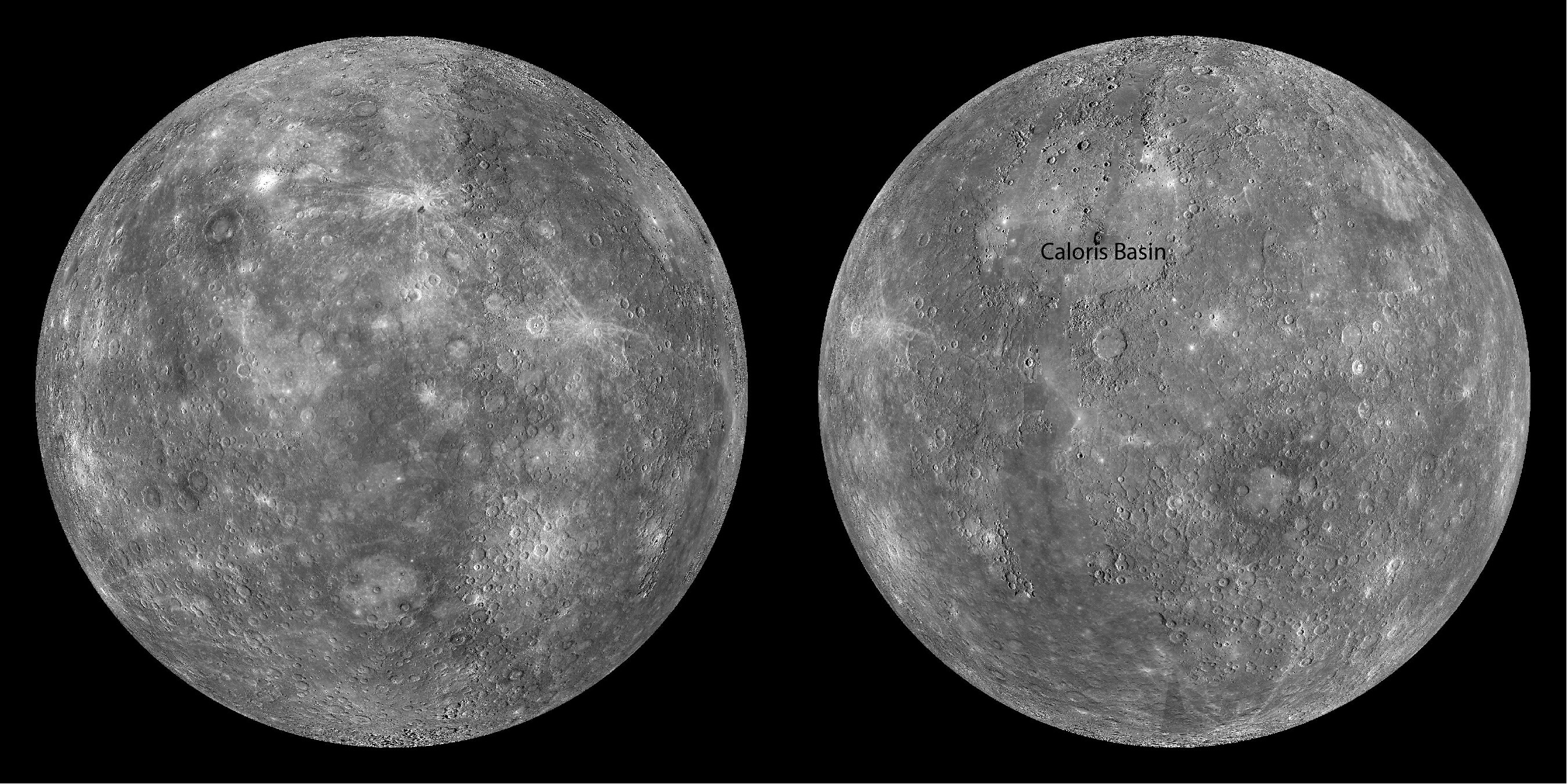
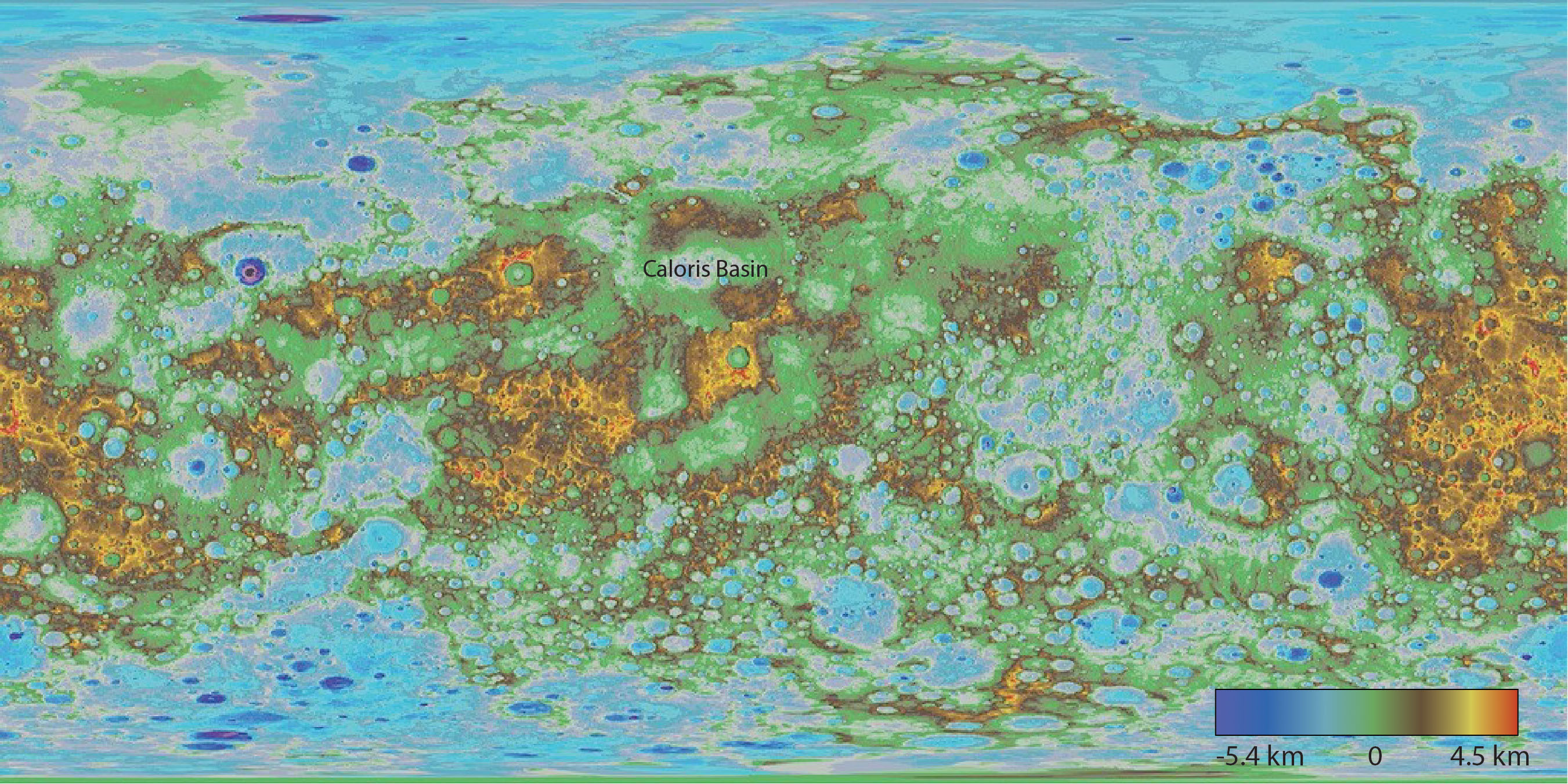
To the naked eye, Mercury is a grayish brown world with abundant impact craters. The heavily cratered terrains are similar to their lunar counterparts, but the heavily cratered regions of Mercury include broad areas of gently rolling plains between the craters and basins. These are the cratered plains and they are the most widespread type of terrain on Mercury (Figure 5.3). (Specialists call them "intercrater plains.") Craters of all sizes are apparent, and clusters of impact craters are common with crater rims overlapping older craters. A few long, bright streaks, perhaps rays from young craters, extend for thousands of kilometers (Figure 5.3). The bright color comes from fresh, ground-up rock thrown out during impact. Locally, the cratered plains are transected by high arcuate cliffs, known as lobate scarps. Finally, the cratered plains are somewhat darker than other parts of Mercury, because of their carbon-rich component. In exaggerated color, carbon-rich crust is blue, and may be areas where Mercury's primary crust has been exposed by impacts (Figure 5.4).
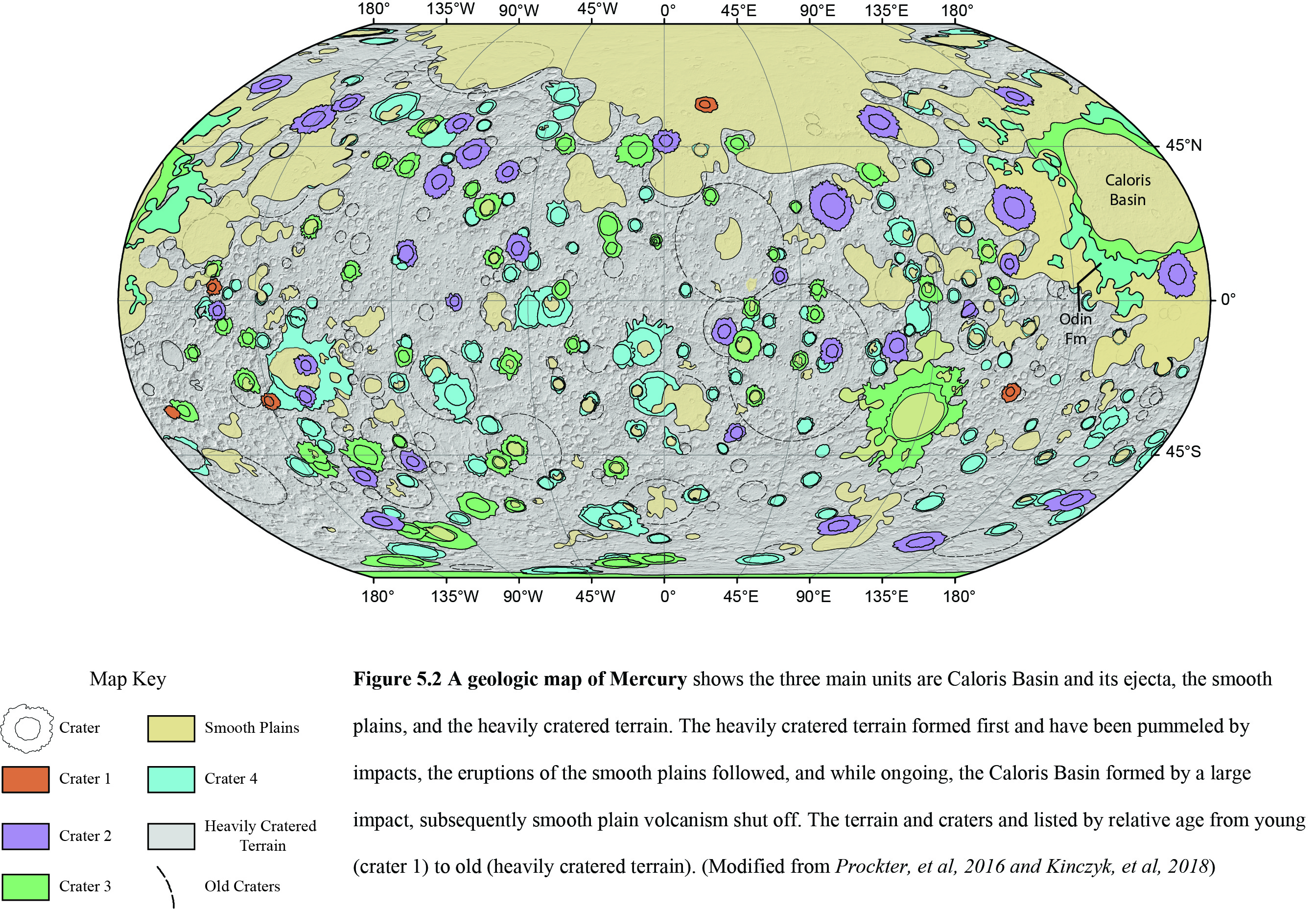
Caloris Basin is one of the largest impact basins in the Solar System, measuring 1550 km from rim to rim (Figure 5.5). Like the lunar basins, it was created by the impact of an asteroid-sized object early in Mercury's development. Caloris is larger than Imbrium Basin (1250 km diameter) on the Moon. Morphologically, Caloris and Imbrium are very similar. The interior part of the basin is covered by lightly-cratered, smooth plains, and is known as -Caloris Planitia. The Caloris plains are extensively ridged and fractured and are unique among the planets---similar features have been found in other impact basins on Mercury, but not on the Moon, Mars, or the satellites of the outer planets. These plains appear to be volcanic in origin based on their smooth surfaces, embayment of older craters, and the presence of a few flow features. The interior rings have been buried by these plains but are apparent as low, concentric ridges. Other ridges are similar to lunar wrinkle ridges, and most likely formed by a similar, contractional process. Shorter arcuate ridges probably formed above lava-flooded craters on the floor of the basin (ghost craters as seen on the Moon).
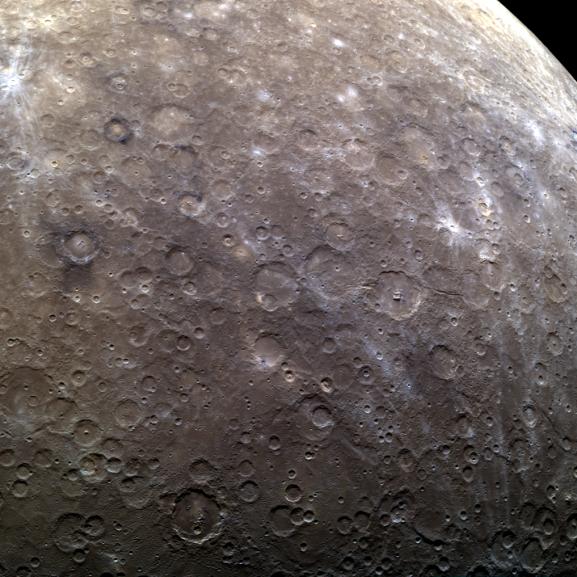
Near the center of Caloris Basin lies a spectacular feature called Pantheon Fossae, which is a system of extensional valleys (Figures 5.5, also see Figure 5.25). The rim of Caloris Basin is defined by Caloris Montes, a series of 2 km high rugged ridges that surround the basin interior (Figures 5.5 and 5.6). Caloris Montes are scoured and rough in appearance and are made up of ejecta deposited from the Caloris impact. The hummocky plains between the blocks of Caloris Montes are probably ejecta that filled in the topographic lows.
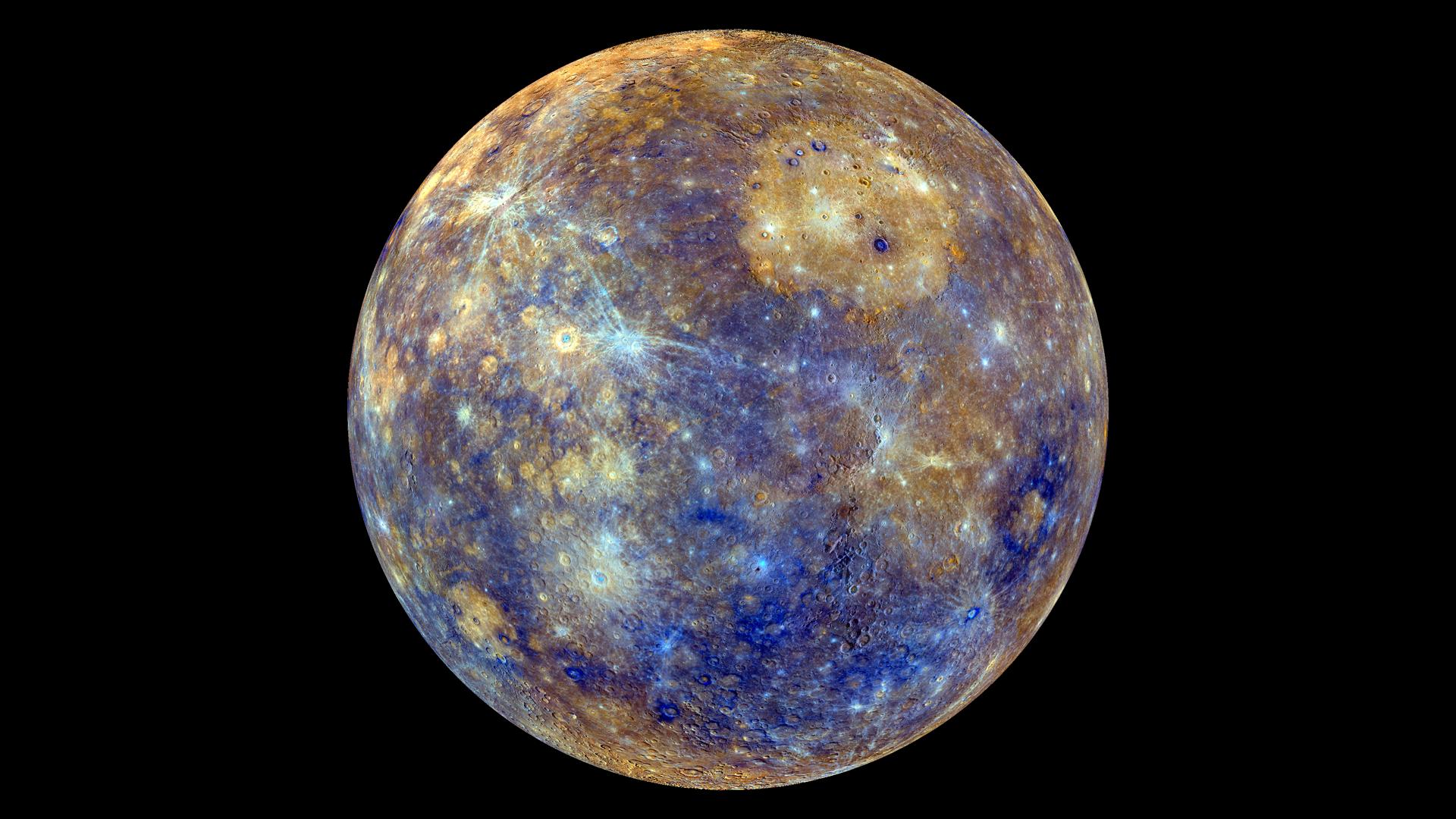
The plains around Caloris are known as the Odin Formation (Figure 5.2), which appears to be ejecta partially buried by younger lava. A lineated zone extends from the Caloris rim out past the Odin Formation to a distance roughly equal to the diameter of the basin. The area is dominated by long, radial ridges and valleys (Figure 5.5). This lineated terrain is best expressed to the northeast of Caloris Basin and is possibly the most rugged topography on Mercury. Similar ridges are apparent around Imbrium and both the lunar and mercurian terrains probably formed in the same way, by catastrophic deposition and erosion of ejecta thrown from the vast crater. An extensive field of secondary crater chains and clusters (groups of closely spaced craters) has been mapped beyond the lineated ejecta showing the large effect the Caloris impact had on the mercurian crust.
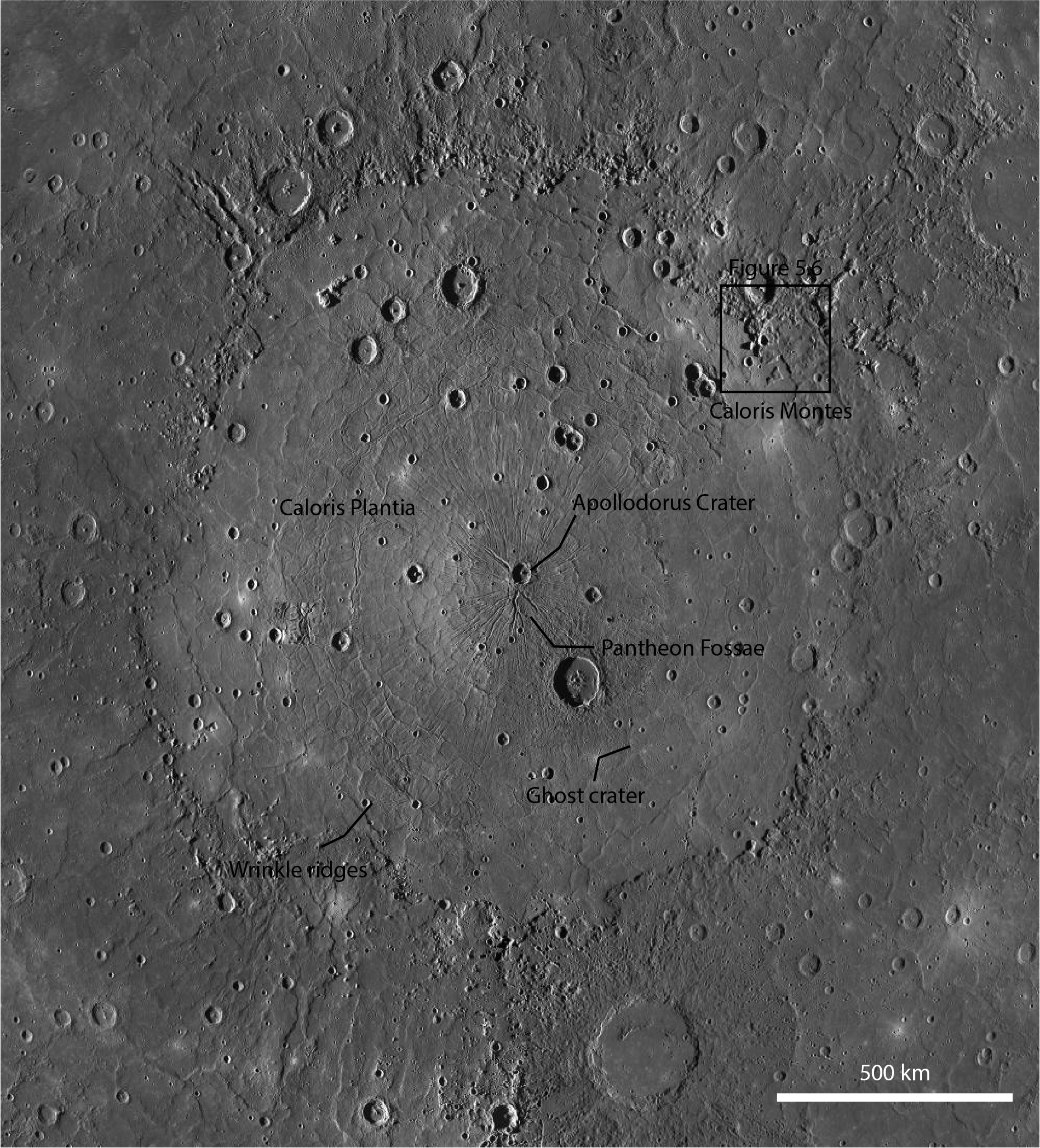
Apparently, the impact that formed Caloris Basin was so great that the effects were transferred to the antipode, or position on the opposite side of the planet as well. A peculiar terrain of hills and linear valleys (Figure 5.7) occupies a region more than 500 km across, centered on the exact opposite side of the planet from Caloris. Perhaps the preexisting crust was broken up by focused seismic waves originating from the impact site. At the point directly opposite the basin, vertical movements of several kilometers were possible from the event. Smooth plains have partially buried this "weird" terrain and are therefore younger.
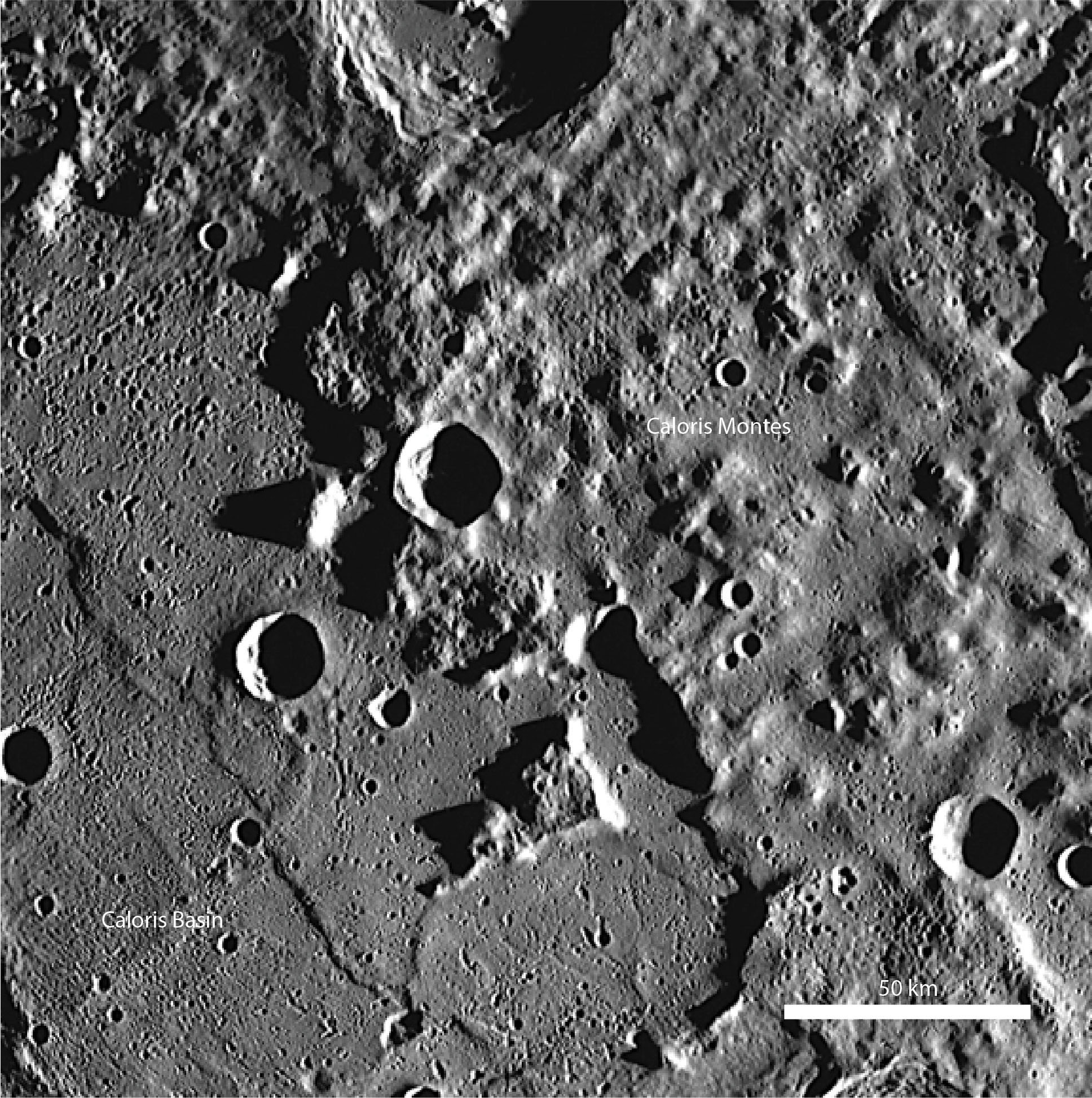
Another major geologic terrain found in several areas scattered around Mercury are smooth plains that resemble the lunar maria (Figures 5.2 and 5.8). This type of terrain covers about 25 percent of the planet and is distinct in that it is very smooth, only sparsely cratered, and is tannish-yellow in exaggerated color (Figure 5.4). The largest area of smooth plains lies near the north pole, possibly reflecting a global asymmetry similar to the asymmetric distribution of maria on the Moon. Numerous other smaller patches are scattered across the planet and can be seen on the geologic map of Mercury (Figure 5.2). Impact structures larger than 10 km in diameter are rare in the smooth plains. The plains are quite level and often fill major depressions, such as impact craters like Caloris. Mare-like wrinkle ridges and lava flow fronts are common within the smooth plains.

The landscape of Mercury is dominated by impact craters of all sizes and states of degradation. These craters constrain the age of major geologic provinces and range in size from small pits to large basins (up to the 1550 km diameter Caloris Basin). The craters have various ages from old, highly degraded depressions to young, fresh, bowl-shaped craters surrounded by halos of bright ejecta and extensive ray systems. In many ways, these impact features are similar to those found on the Moon and asteroids. However; close examination reveals that the mercurian craters differ from lunar craters in several important aspects.
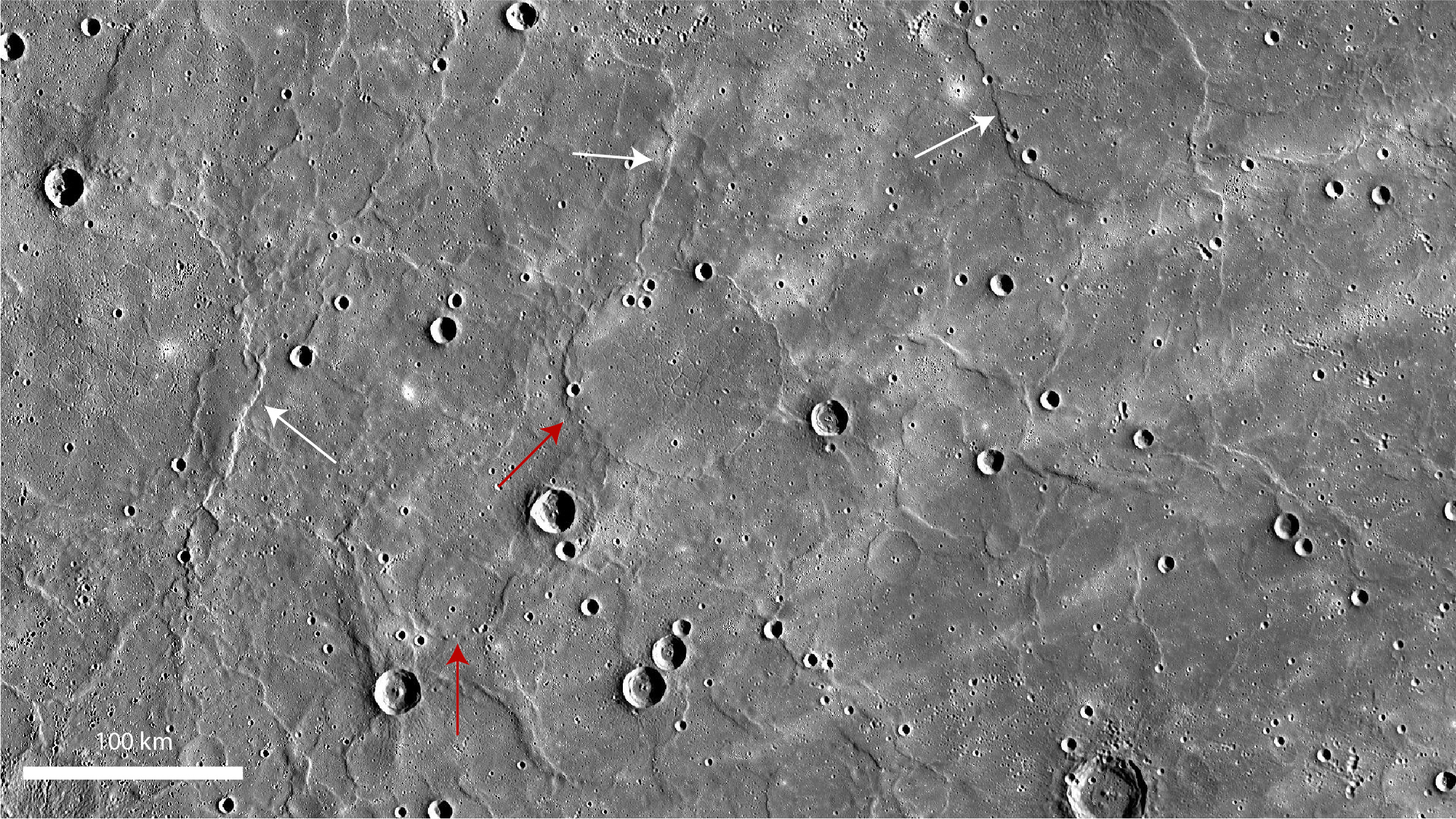
As discussed in the chapter on the Moon, crater density indicates the age of a planetary body and its different areas. The crater density on Mercury's cratered plains is less than on the Moon's heavily cratered highlands (Figure 5.9). Also, for any crater diameter, there are fewer craters on the mercurian cratered plains than on the lunar highlands. This difference is especially strong for craters greater than 100 km across. So, the rolling plains between the craters hint at what careful crater counts show about Mercury's cratered plains; even though the plains are the oldest surfaces on Mercury, they do not date back to the accretion of the planet like the heavily cratered highlands of the Moon. Based on crater density, the cratered plains are 4.1 to 4.0 billion years old; the lunar highlands date back to 4.4 billion years ago.
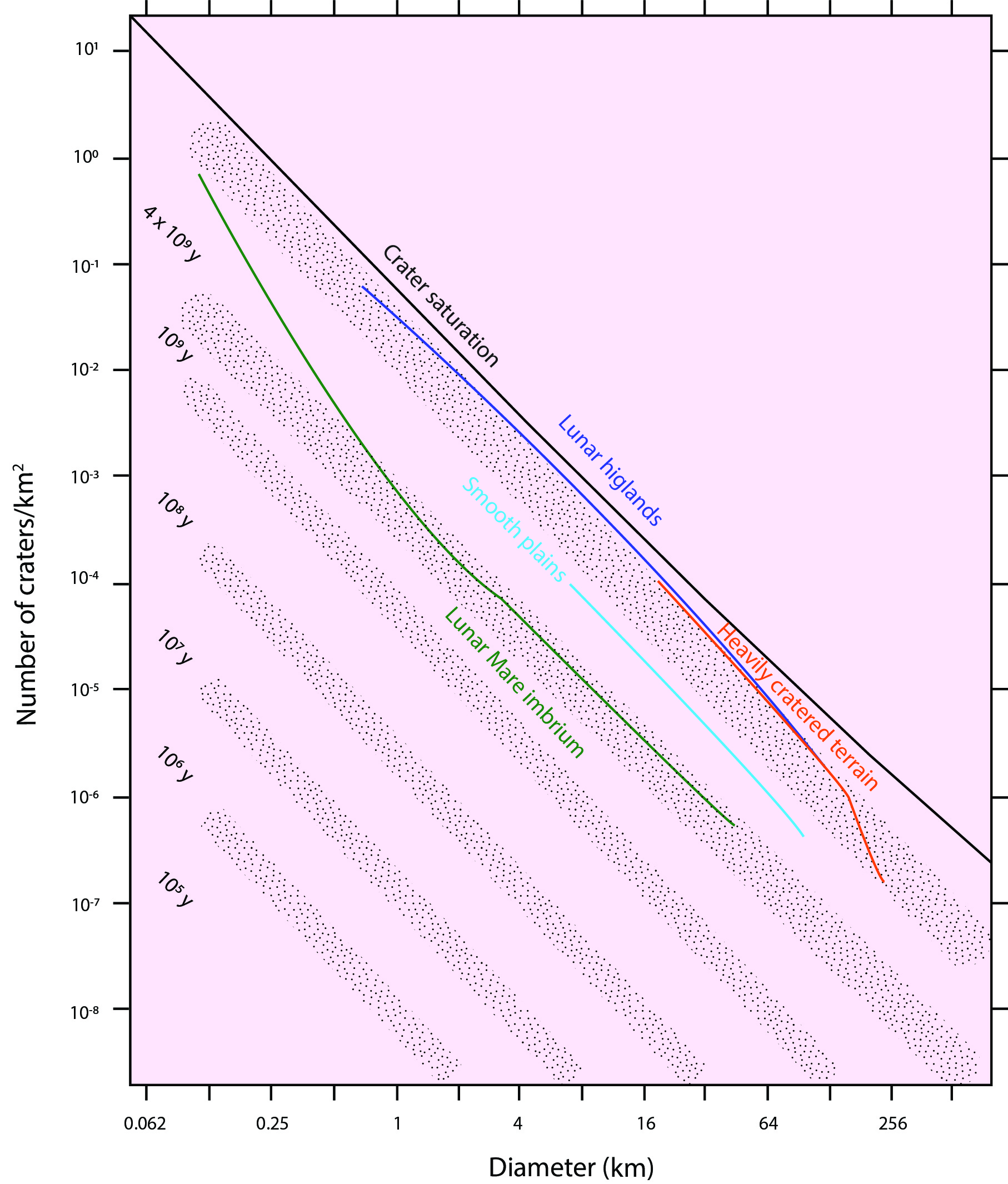
Why aren't the cratered plains of Mercury as old as on the Moon? Let's examine some of the facts. In addition to having fewer craters, the cratered plains vary in age across Mercury. The younger age and broad age distribution were probably caused by the same thing--active volcanism during the intense bombardment that followed accretion. Many of the early impact craters were buried and eventually erased by eruptions of voluminous lava flows. As a result, the oldest craters were completely destroyed. The craters apparent today on the cratered plains must have formed during and after the Late Heavy Bombardment, which started about 4.1 billion years ago-apparently when the orbits of the outer planets were rearranged and a shower of asteroidal bodies peppered the planets of the inner solar system
As shown by the stratigraphic relations between the smooth plains and the cratered plains, the smooth plains are the youngest major terrain on Mercury. This conclusion is, of course, supported by its sparse crater population (Figure 5.9). The emplacement of the smooth plains, after the cratered plains formation, buried craters dotting the cratered plains and smoothing out the surface. In many instances, the smooth plains were not thick enough to completely bury large craters leaving smoothed out, but still visible craters.
A major physical difference between the Moon and Mercury that affects crater morphology is their surface gravity, Mercury's is twice that of the Moon. Mercury is both larger and denser than the Moon and its gravitational field is thus stronger. On Mercury, the distances that ejecta and secondary craters travel from the primary crater are systematically shorter for a given crater size on Mercury than on the Moon because of Mercury's greater gravity (Figure 5.10). Greater gravity pulls ejecta down to the surface in a shorter amount of time, and thus at a shorter distance from the source. This mechanism also explains why secondary craters are more clustered around mercurian craters than lunar craters. Since ejecta is spread out over a smaller area on Mercury, the ejecta blankets must be thicker and will have an increased ability to degrade or bury nearby craters. The zone of secondary craters is often marked by long, linear grooves that radiate away from the crater. The grooves are produced by the impact of closely spaced ejecta fragments that fall closer to the crater, and are more pronounced than their lunar counterparts. Mercury's greater gravitational pull likewise gives ejected blocks higher velocities. The higher speed produces larger, more prominent secondary craters upon impact on Mercury than the Moon.

The transition and progression of impact craters from simple to complex occurs at smaller diameters on Mercury than the Moon (Figure 5.11). This difference has been attributed to higher speeds (42 m/s, compared to 11 m/s for the Moon) of impactors because of Mercury's proximity to the Sun, and not the gravity of Mercury. Other factors, such as impactor and target rock strength and porosity, may affect crater morphology progression in smaller ways.
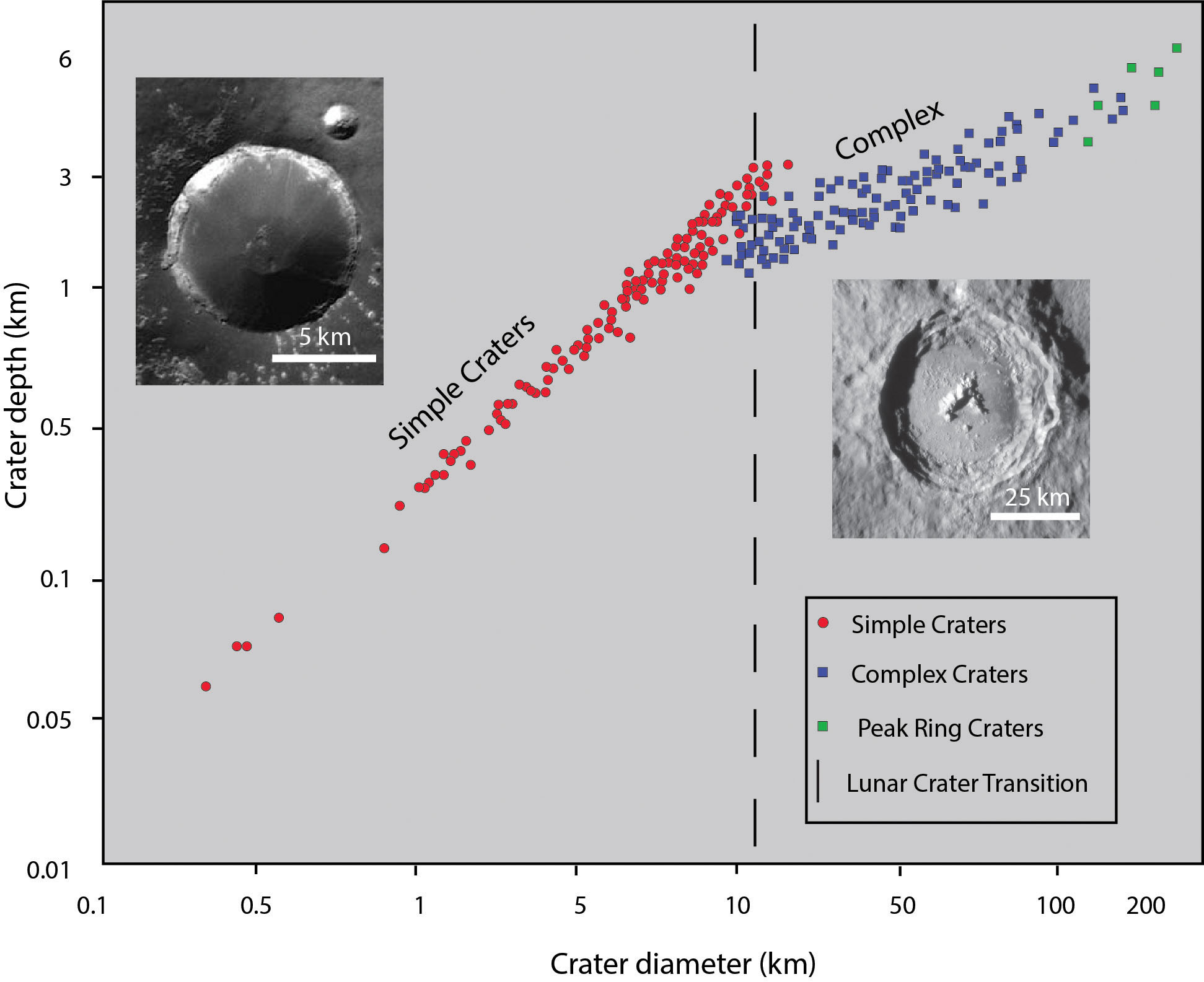
Even though complex craters start to form at smaller diameters on Mercury, the types of craters that form are the same as those on the Moon. Small craters on Mercury are simple and bowl shaped. With increasing size, terraces on the crater walls become apparent and central peaks develop, then irregular clusters of peaks appear. The largest impact features are basins with inner rings (Figure 5.12). Apparently, neither gravity nor impact velocity change the forms or the progression order of craters. Although the resultant feature is slightly different, the cratering process is fundamentally the same on both planetary bodies.

Large, multiple--ring basins, similar to those on the Moon, are also found on Mercury. The most common are relatively small, ranging from 200 to 600 km in diameter. These craters usually have an irregular inner ring, an outer terraced rim, and an ejecta blanket with numerous secondary craters. Such peak ring basins are more common on Mercury (Figure 5.13) than on the Moon (110 on Mercury vs. only 7 on the Moon). Typically, the peak rings are prominent and fresh. In other cases, the rings are partially or completely flooded by volcanic material.
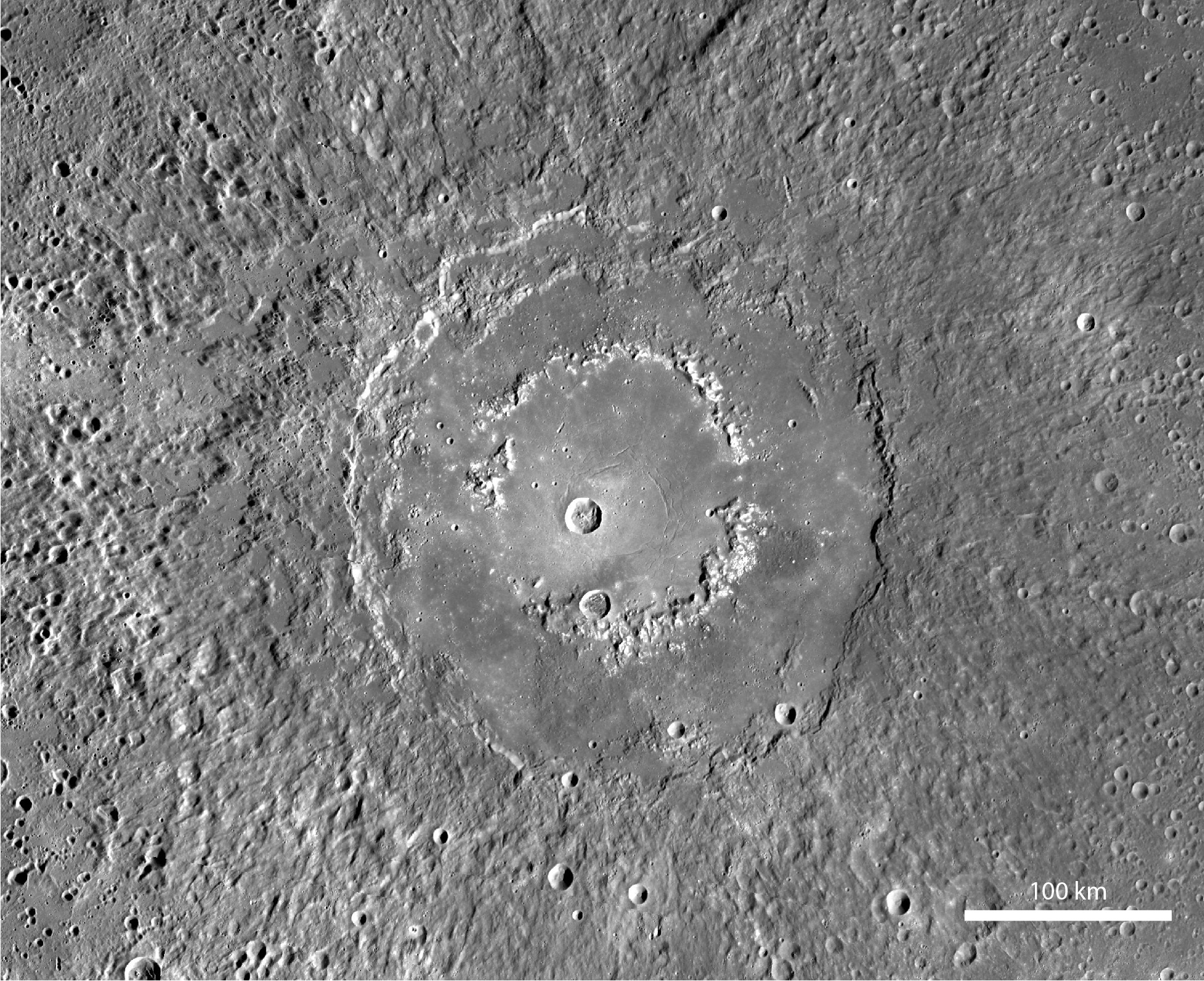
Compared to the Moon, large multiring basins are far less common on Mercury (there is only one - Caloris). One way to explain this apparent lack of large basins centers on an observation regarding the state of isostatic adjustment of old basins where the lithosphere rises because crustal material has been removed above it. A different explanation for the small number of mercurian basins was alluded to in the description of the intercrater plains. These volcanic plains appear to have formed during the Late Heavy Bombardment, and their emplacement may have destroyed many older impact basins.
As on the Moon, the dominant erosional processes on Mercury are caused by impact cratering; subordinate processes include tectonism, space weathering (removal of elements by light particles or meteor impacts), volcanic burial, and topographic relaxation (isostatic adjustment). Degradational sequences have been established for mercurian craters showing the morphologic changes with increasing age (Figure 5.14). The freshest craters are young, with well-defined rims, hummocky ejecta blankets, and systems of bright rays comparable to Copernicus and Tycho on the Moon. Numerous rayed craters from 1 to 50 km in diameter dot Mercury's surface (Figure 5.1). Subsequent bombardment breaks down the crater rim and churns up the ejecta blanket or completely buries it beneath other ejecta deposits. Ultimately, the crater is transformed into a low-rimmed depression with large numbers of younger, superposed impact features. Many of the original crater features become completely obliterated or barely recognizable. Degradation of mercurian craters by impact from secondary fragments does not occur as far from the primary crater as on the Moon because of shorter ballistic ranges.
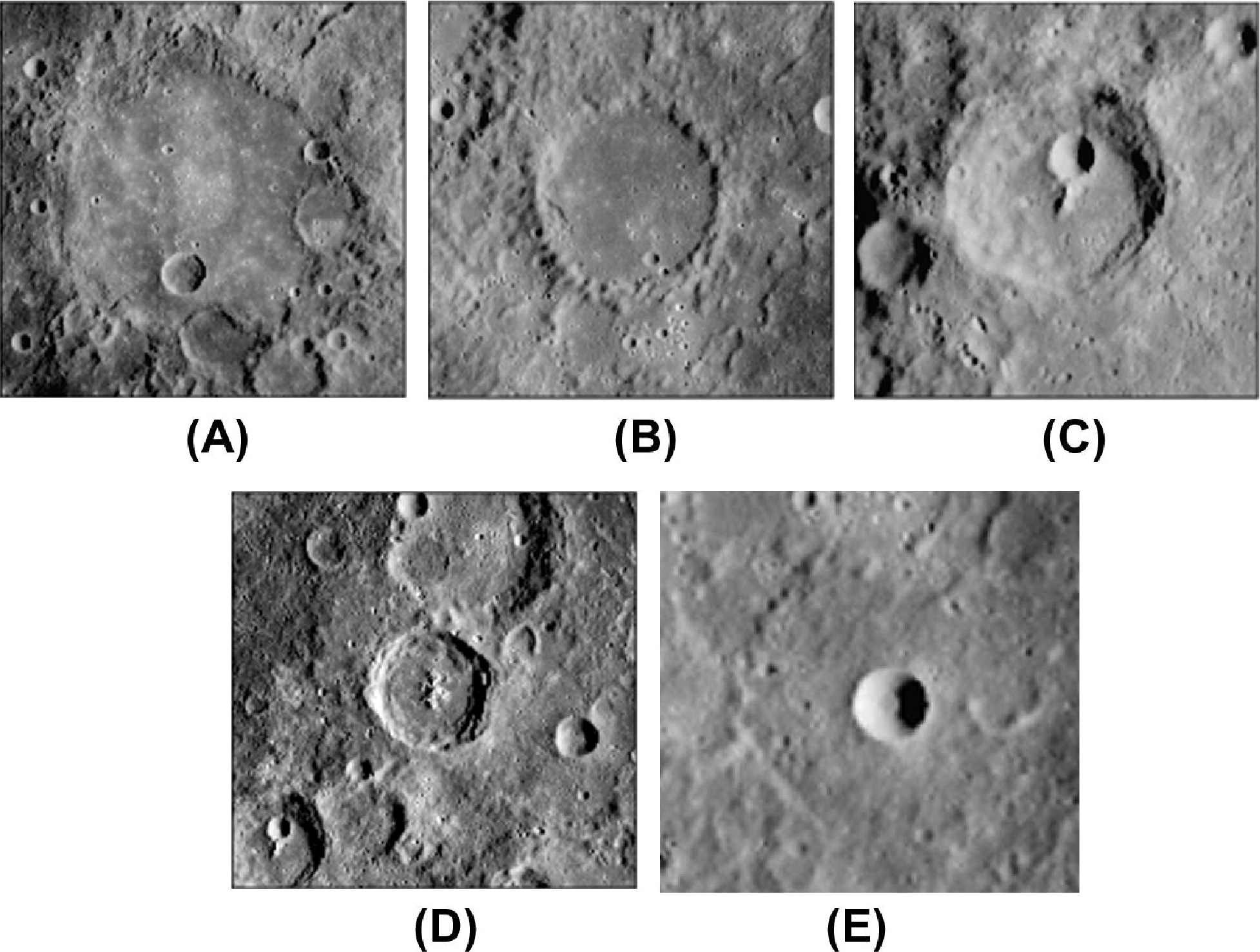
Another degradational process centers on the state of isostatic (gravitational) adjustment of old basins, wherein a crater tries to flatten itself out in the same way that a pit in viscous tar slowly disappears as material flows in to remove the cavity. Of course, silicate rocks flow much slower than tar and may not flow at all if the lithosphere is cold and strong. Perhaps Mercury's crust cooled more slowly than the Moon's, remained pliable and "plastic" longer, and was able to adjust more rapidly to erase the signatures of ancient impact basins.
In summary, mercurian impact features differ from lunar craters and basins in three important ways. First, the ejecta thrown out of craters on Mercury does not travel as far as on the Moon. Considering the larger strength of the mercurian gravitational field (almost twice the Moon's) this is logical. Second, even the most densely cratered terrain is not saturated with craters and is younger than the lunar highlands. Apparently, the oldest impact structures were removed by some process, probably due to viscous relaxation or volcanism before and during the Late Heavy Bombardment. Third, many of the ancient mercurian basins are very shallow and ill-defined as a result of the relaxation and volcanism.
Magmatism and volcanism have been important parts of Mercury's geologic history, and volcanic rocks are a significant component of its surface. Two types of volcanism have occurred on Mercury: effusive and pyroclastic volcanism. Effusive volcanism produces lava flows, such as those on the lunar maria or on the island of Hawaii today, and can cover large areas (link). Pyroclastic volcanism (link) occurs when bubbles of volatile gas separate from molten magma and explosively expand and pop (link). Some magma has been trapped beneath Mercury's surface to form intrusions.
Magmatism and volcanism have been important parts of Mercury's geologic history, and volcanic rocks are a significant component of its surface. Two types of volcanism have occurred on Mercury: effusive and pyroclastic volcanism. Effusive volcanism produces lava flows, such as those on the lunar maria or on the island of Hawaii today, and can cover large areas. Pyroclastic volcanism occurs when bubbles of volatile gas separate from molten magma and explosively expand and pop. Some magma has been trapped beneath Mercury's surface to form intrusions.
The processes by which magma forms and erupts on Mercury are the same as those that operated on the Moon. Magma forms by partial melting of the mantle, producing a mix of crystals, dissolved gas, and liquid collectively called magma (Figure 5.15). Magma formed by partial melting deep inside a planet typically has a density less than that of the overlying rock. This contrast in density produces a positive buoyancy force on the magma and it rises upwards. As magma accumulates into larger amounts, it may exert pressure on the overlying rocks and cause fractures to develop. These magmatically induced fractures provide conduits through which magma reaches the surface. The upward movement of magma will continue until (a) it erupts on the surface, (b) stalls because it intrudes rocks with a lower density than the magma or (c) stalls because the strength of the rock is greater than the buoyancy force. If the magma stalls, it can pool to make a large magma reservoir, which may then cool and crystallize as an intrusion or pluton (refer to figure 2.18).
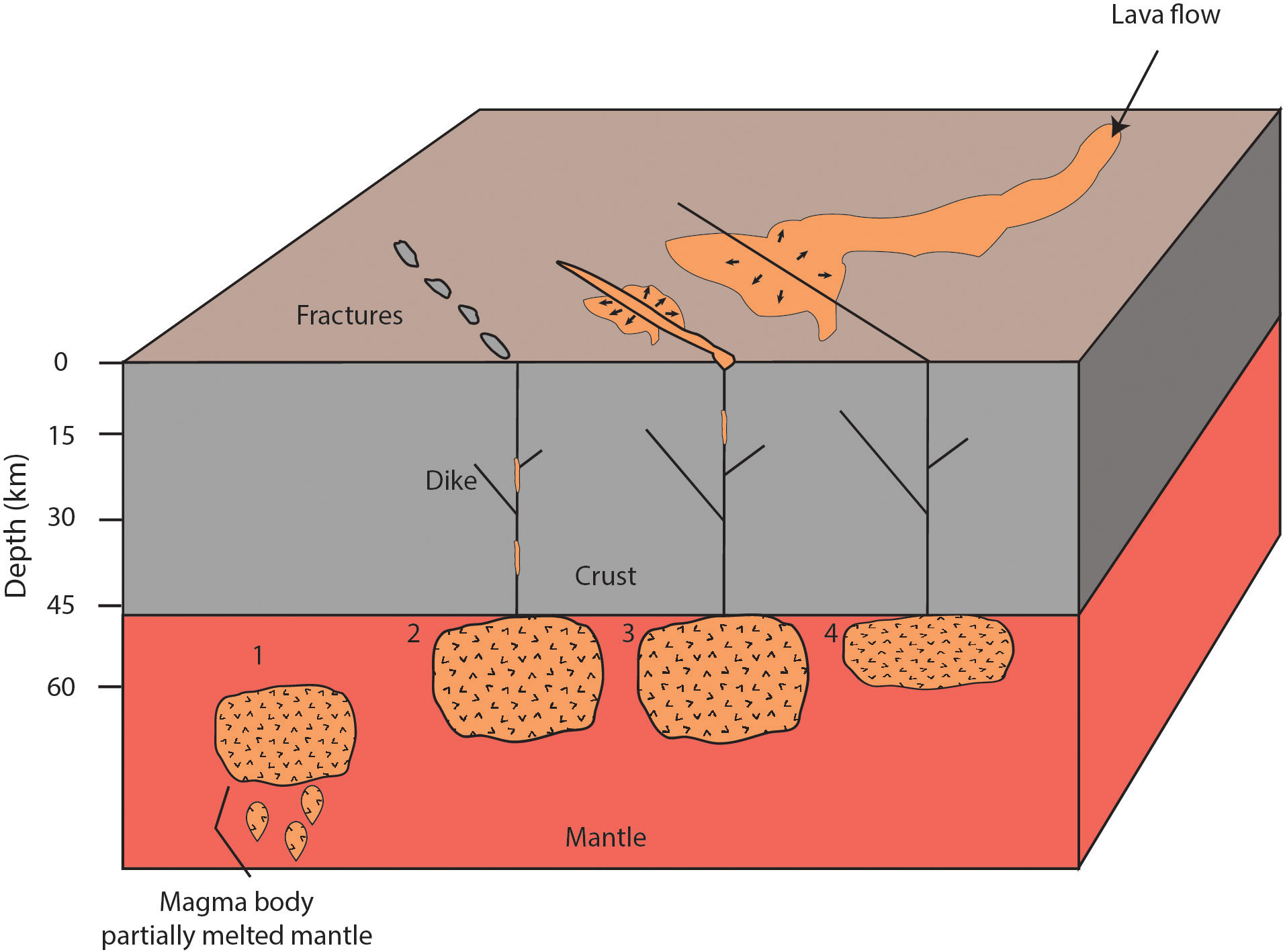
Before the MESSENGER mission, multiple suggestions for the origin of the mercurian smooth plains were given, including formation by ballistic erosion and deposition of ejecta associated with the formation of major impact basins, notably Caloris. According to this hypothesis, as impact-energized debris surges (high velocity movement of material) moved away from Caloris, they may have ponded in depressions, creating smooth plains in the same way that the lunar highland plains (like those that fill Ptolemaeus, Figure 3.19) formed. But most of the mercurian plains are younger than Caloris, the youngest impact basin of an appropriate size, which is a weakness of this explanation. Small patches of smooth plains within craters may also arise by mass wasting from the walls.
On the other hand, many planetary scientists believed the smooth plains formed by extrusive outpouring of fluid mafic (iron or magnesium-rich) lavas, much like those that formed the lunar maria. With higher resolution images from MESSENGER, more volcanic features were observed on the smooth plains, favoring a volcanic origin. The evidence supporting a volcanic origin includes: (1) the large volume of material that accumulated to form smooth surfaces, (2) differences in the volume of plains material in craters and basins of the same size, (3) the striking similarity in morphology and distribution of the smooth plains and the lunar maria, (4) the age differences between the smooth plains and the basins they occupy, (5) the presence of lava channels, (6) buried impact craters, (7) lack of clear association with impact craters of the right age, (8) lobate flow similar to volcanic flow fronts on other planetary surfaces, (9) high potassium concentrations that can be associated with volcanism, (10) differences in geochemistry between the crated plains and ejecta of craters. These observations show the majority of the smooth plains are volcanic and not impact ejecta deposits
Throughout large areas, the plains material is thought to be approximately the same thickness (1-1.5 km) as the mare basalts. In many places, however, the smooth plains do not completely bury the older impact craters and their rims, which are mostly lower than 1.5 km and protrude through the cover of lava. Thus, on a regional scale, the young volcanic cover is incomplete and discontinuous.
The lava flows that make up the volcanic cover bury or embay preexisting impact craters, lowering the impact crater density and producing a smooth, and younger surface. The impact crater density of the northern plains suggests a formation age between 3.7 and 3.9 billion years, before the planet cooled enough to create a thick lithosphere that magma could not penetrate (see Figure 5.31). There is some debate on the ages of the lava flows in Rachmaninoff basin; some suggest these flows may be as young as 1 billion years old. However, it is difficult to tell, because it is a small area and crater density calculations are less reliable over small areas.
The majority of Mercury's volcanic eruptions appear to have formed by a process similar to that which formed the lunar maria ---quiet fissure eruptions of fluid, basaltic magma. These materials ponded in depressions, covering most of the vents through which lava rose to the surface and preventing the development of steep-sided volcanoes like those on Earth. The mafic (Figure 2.16) composition of these lavas was determined by x-ray spectrometric measurements made from orbit that showed these lavas have uncommonly low concentrations of iron and high concentrations of magnesium. This high magnesium content and their high temperatures (1300 °C; mafic magmas with high magnesium content typically have hotter temperatures) made the lavas very fluid, so they could flow long distances and pond over their vents. They probably had the approximate consistency of motor oil.
While most of the effusive volcanism produced smooth plains with no lava flow features, there is one area on the eastern edge of the northern smooth plains that does (Figure 5.16). Two large impact craters have been filled by lava and are connected by a wide valley that, at one time, was filled with a flood of flowing lava 10 to 20 km across. These lava channels are similar to the sinuous rilles on the Moon's volcanic maria. The floods of lava thermally eroded (melted rocks on the floor of the channel) pre-existing fractures into wide lava channels. Tear-drop shaped "islands" were left as erosional remnants of the cratered plains. The channels lead into other impact craters that flooded, and in some instances overflowed, with lava. To create such features, the lavas must have been very fluid and erupted at exceptionally high rates
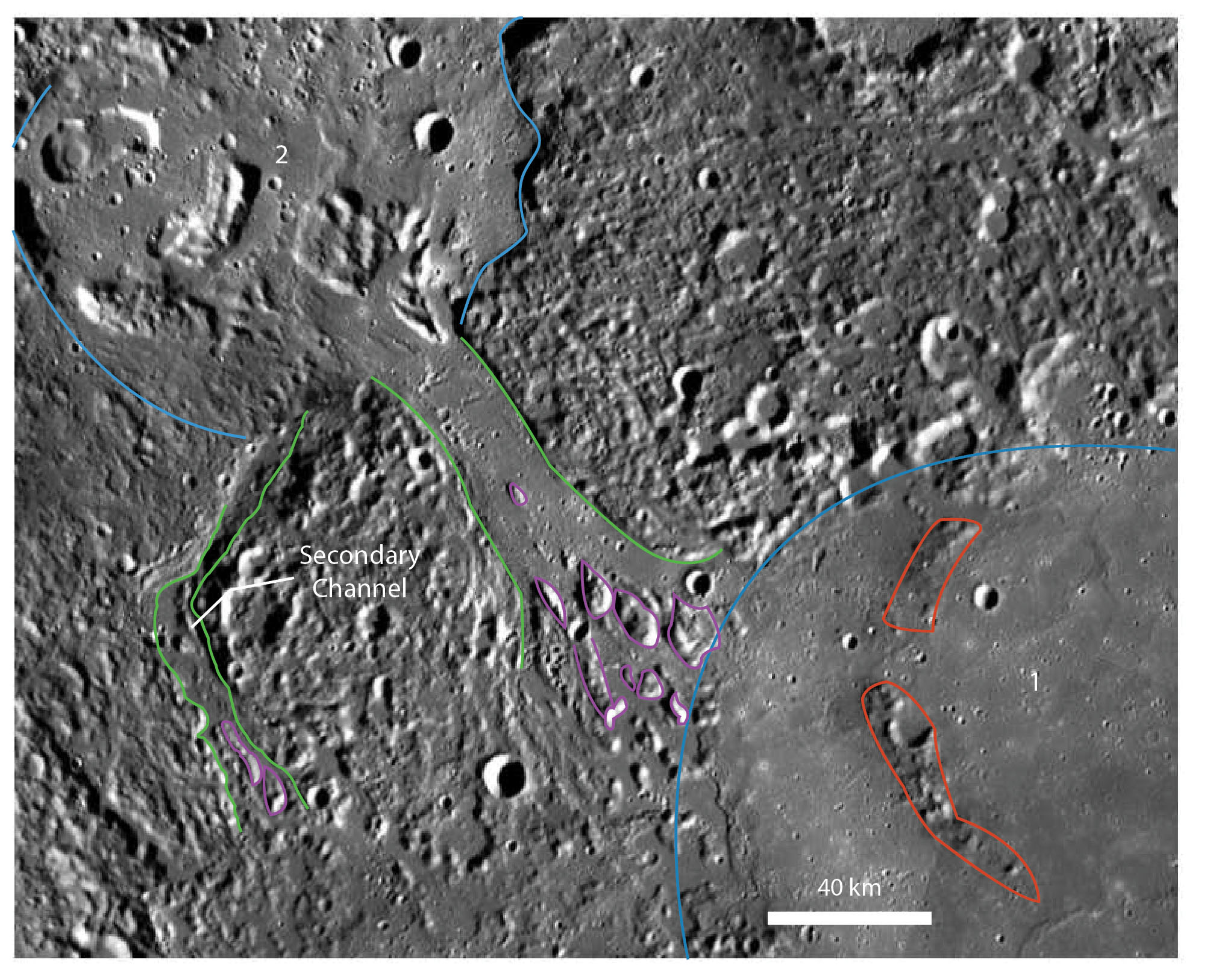
One of the more exciting discoveries made by the MESSENGER mission was the identification of many small pyroclastic volcanoes scattered across the intercrater plains. Pyroclastic eruptions are explosive; lava and rock fragments are violently thrown outward from the volcanic vent. Pyroclastic deposits have been found on the Moon but they are uncommon. These types of eruptions result when volatiles within the magma separate (exsolve) from the magma to form bubbles that then expand and rupture explosively at low pressure. The volatiles in magmas are typically water, but may include carbon monoxide (CO), carbon dioxide (CO2), sulfur (S in various forms), or methane (CH4). The Earth experiences very violent pyroclastic eruptions (e.g., the stratovolcano of Mount Saint Helens in Washington or the large calderas at Yellowstone National Park in Wyoming) because terrestrial magmas are different-they have high water content and are rich in silica. Silica-rich magmas are "stronger" so that when bubbles explode, they do so very energetically. Such water-rich silicic magmas are rare on other planets-including Mercury.
The volcanoes produced by pyroclastic eruptions on Mercury (Figure 5.17) have irregularly shaped pit craters surrounded by diffuse and bright haloes. The circularity of these haloes is one evidence that the volcanoes are largely shaped by explosive eruptions ejected out of a single vent, instead of a multitude of fluid eruptions of different volumes and durations that would have led to irregularly shaped lava flows of different lengths. The bright, diffuse deposits have an average radius of 25 km. The centrally located pit craters are tens of km across (similar in size to Crater Lake in Oregon), and reach depths of as much as 4 km, with no estimates on rim height. The irregular pit shape is probably the result of multiple eruptions at the same location, widening and reshaping the pit with each eruption. In other instances, these pits might result from collapse of a magma chamber after eruption and magma withdrawal.
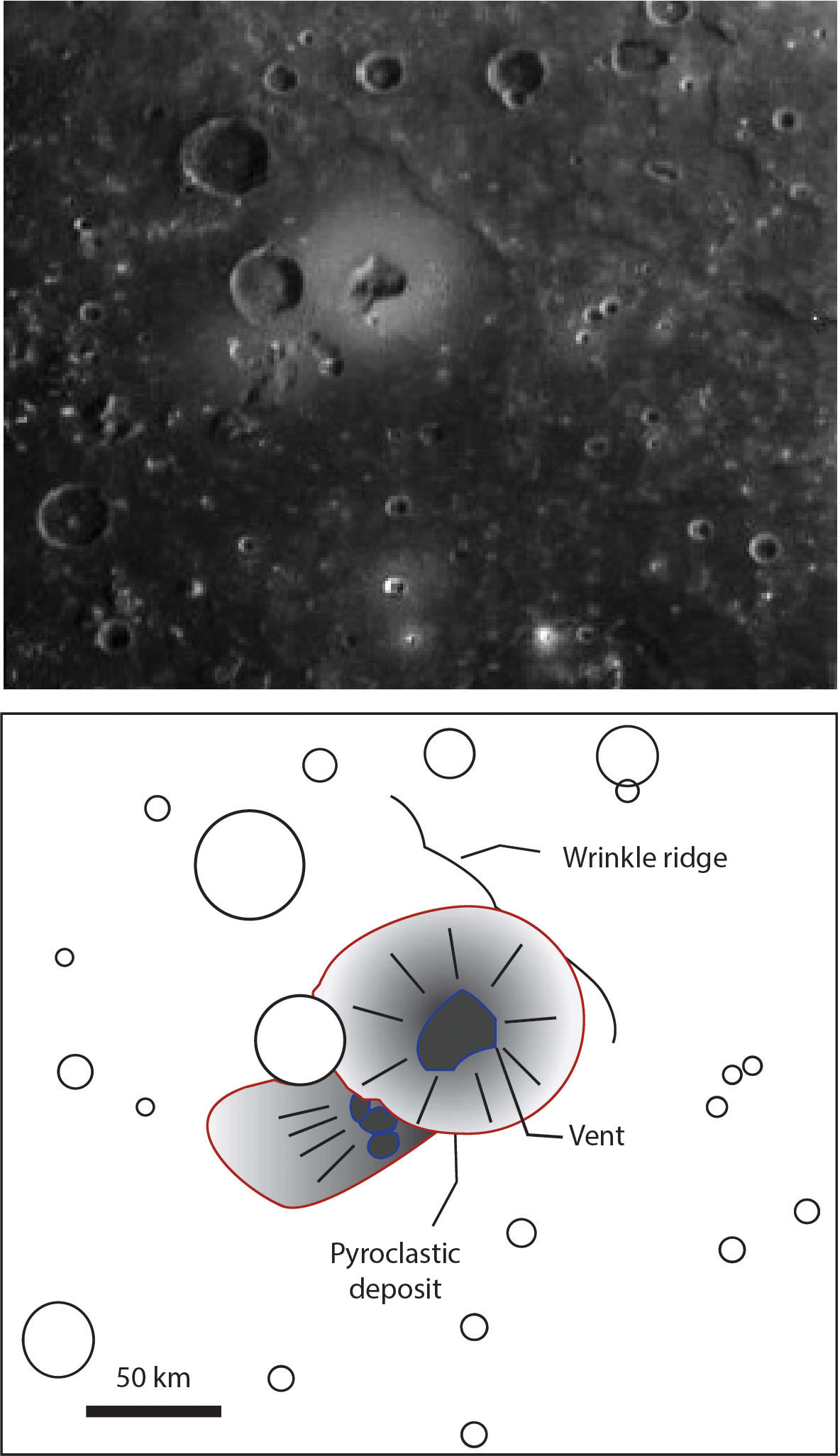
These pyroclastic volcanoes are spread throughout the intercrater plains, the edges of the smooth plains, and around Caloris Basin's rim (and other crater rims). Pyroclastic eruptions began around 3.9 billion years ago and appear to have continued until relatively recently (about 1 billion years ago). However, dating the pyroclastic volcanoes is difficult at best. Because of their small sizes and thicknesses, it is difficult to obtain accurate impact crater frequencies. Since many of these volcanoes are inside impact craters, the age of the crater constrains the age of the volcano. This technique does not give precise ages, but because the volcano must be younger than the impact crater, it gives the upper limit of the volcano's age.
For pyroclastic eruptions to occur, the mercurian magma must have volatiles-on the order of a few thousand parts per million or more- and a pathway to the surface. High volatile concentrations like this can result from several processes (Figure 5.18). 1) The interior of Mercury might have high concentrations of volatiles, and therefore a magma derived from it will have a high concentration of volatiles as well. 2) A dry magma could intrude into a volatile-rich layer and assimilate (melt and incorporate) the volatiles or explode as it reacts with them. 3) Even if a magma initially is volatile-poor, the volatile concentration can increase as the magma crystallizes minerals that do not contain volatiles, leaving the volatiles in the residual melt, and thereby increasing their concentrations. In reality, the concentration of volatiles in mercurian magma is most likely a combination of all these processes. Based on the volcanoes and size of the deposits, Mercury's pyroclastic eruptions were less violent than Earth's (more like fire fountains on Hawaii or a cinder cone like Mexico's Paricutin volcano (Figure 5.19)), probably because of the planet's lower volatile content (~2 weight percent in mercurian magmas) and the more fluid, mafic composition of its lavas. Keep in mind that many silicic, explosive terrestrial magmas have volatile concentrations exceeding 10,000 parts per million (as much as 7 weight percent (70,000 ppm) water plus other volatiles).
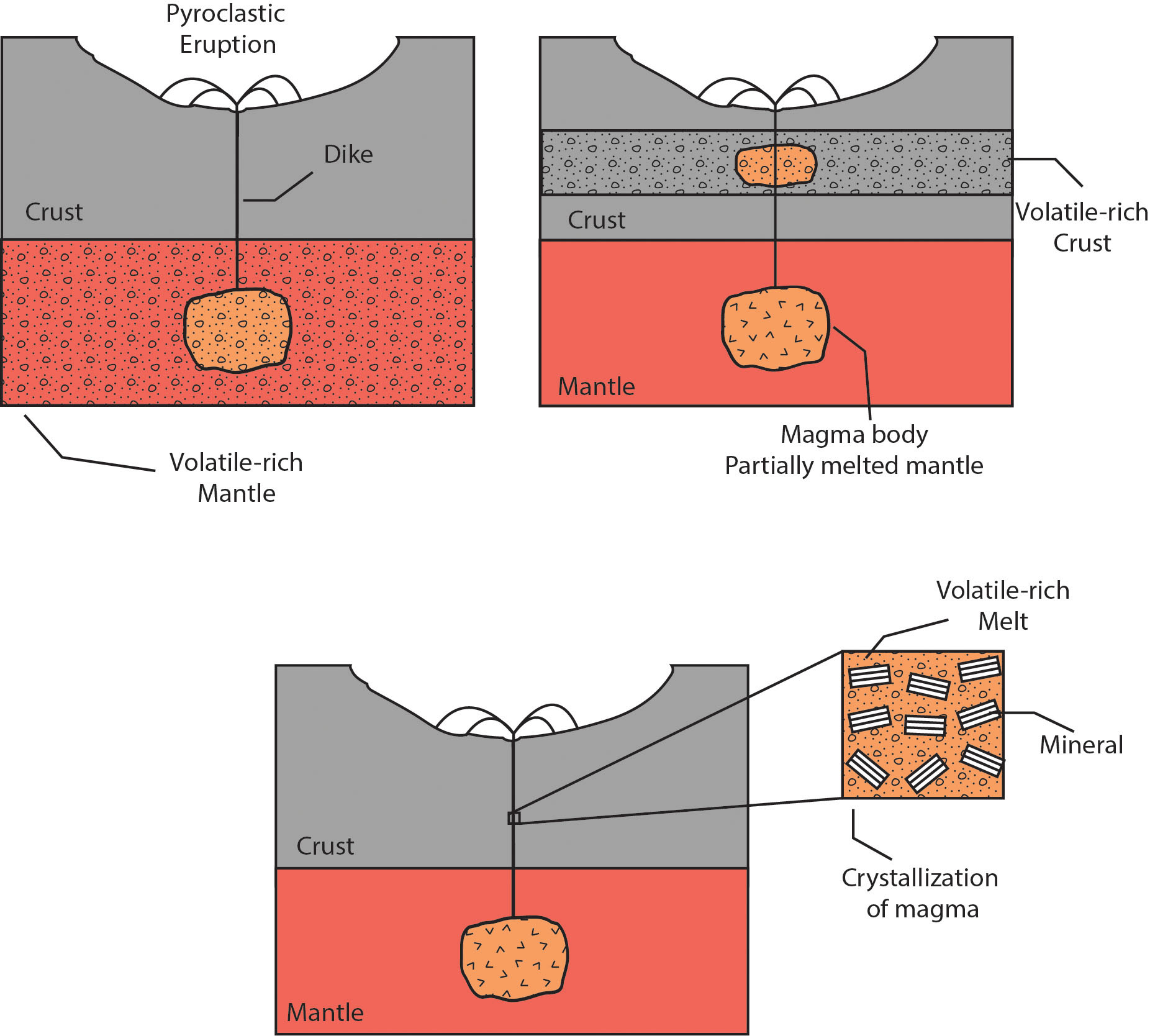
In addition to having volatile enrichment, a mechanism for the magma to reach the surface needs to exist. This would have been easy early on, when the lithosphere was thin, and extensional fractures readily developed. However, a billion years into Mercury's history, the lithosphere would have been too thick for magma to easily traverse the crust. Moreover, as Mercury cooled and its lithosphere thickened, it started to contract, making it even more difficult for magma to fracture its way to the surface. The association of volcanic craters with impact craters (for example, those concentrated along Caloris Basin's rim) provides an important clue to how the magmas reached the surface. Impact fractures penetrate deep into the crust, providing weaknesses or pathways for magma to rise. As magma rose along the fractures, the volatiles could separate at increasingly lower pressures, preparing for explosion. (The release of volatile gases at low pressure is the same process that occurs when bubbles of carbon dioxide form and pop when a can of shaken soda is opened.) The volatiles separate and then expand in an explosive manner, blasting rock and magma fragments into ballistic trajectories. The pyroclasts land on the ground in a circle around the vent, much like the eruptions that formed the dark halo deposits on the Moon (Figure 4.34) and which form cinder cones on Earth (Figure 5.19). But because of the low gravity, particles were thrown farther from the vents than on Earth and the pyroclastic cones are not as high.
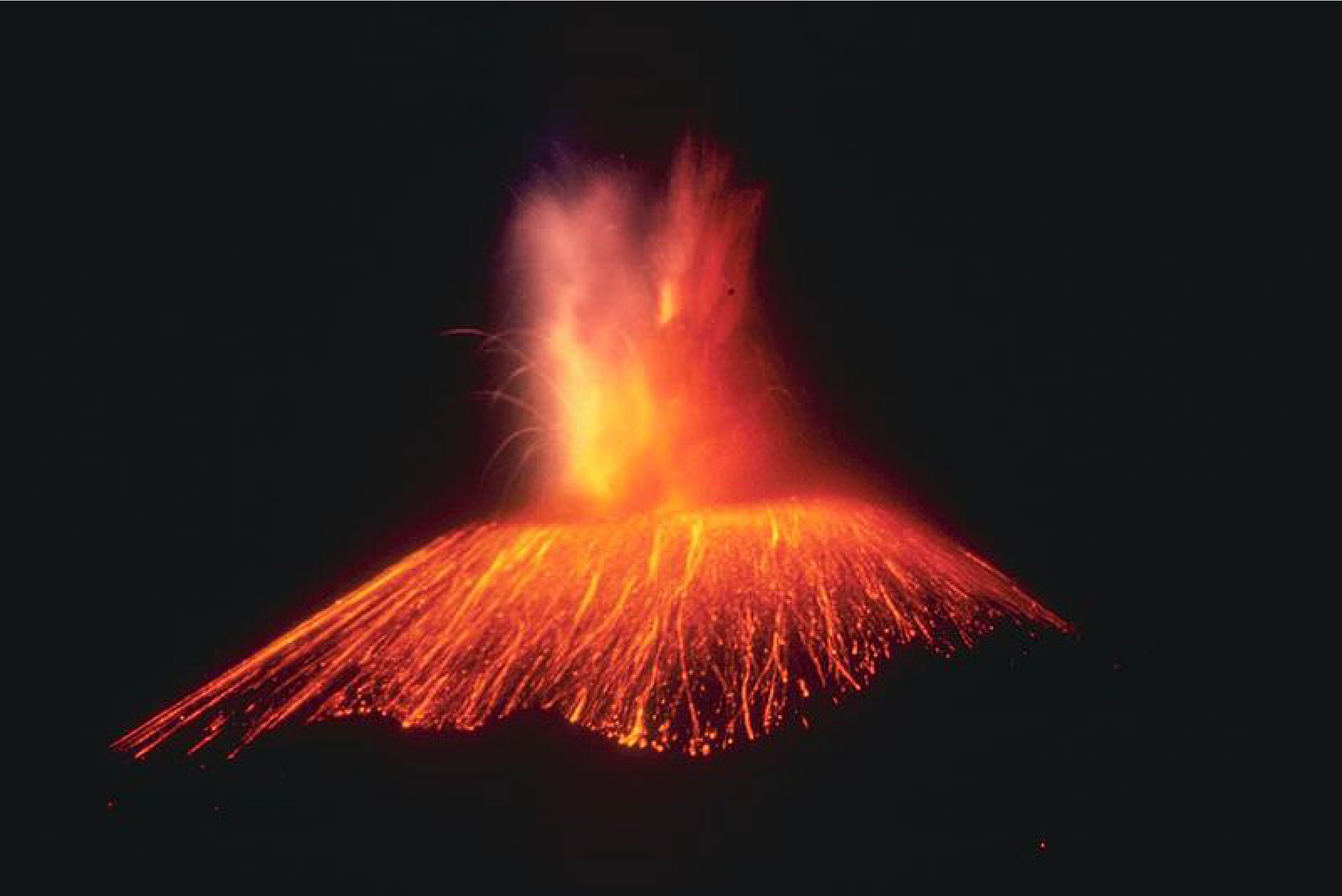
The presence of pyroclastic deposits on Mercury was unexpected because of its proximity to the Sun. Anciently, when materials condensed around the forming Sun, minerals with volatiles like water and carbon dioxide were not stable at the high temperature found there. Consequently, some scientists predicted that Mercury would be volatile poor. However, the presence of pyroclastic volcanoes, and some other features described below, indicate Mercury is more volatile rich than previously thought.
On the way to surface eruptions, magma intrudes the crust. Sometimes, the magma does not erupt, but is trapped and solidifies underground. Since volcanism occurred on Mercury, we are quite certain that intrusive rocks (plutons) formed as well. Uplift and erosion may not have exposed once buried intrusions as has happened on Earth, but there are a few pieces of evidence of intrusions in the form of extensional features at Mercury's surface. Grabens form, as explained above, when magma is injected into the crust; this causes stretching and expansion over the roof of the dike or intrusion, and the crust can fracture. The manifestation of such underground fractures are narrow grabens at the surface.
One of the most prominent impact craters with evidence for intrusive magma emplacement is Raditladi Basin. It has concentric grabens within its peak-ring (Figure 5.13). The grabens probably formed by emplacement of dikes in the shape of cones emanating from a central magma chamber (Figure 2.18) creating circular grabens on the surface. Such craters with subsurface intrusions are called floor-fractured craters. Pantheon Fossae (Figures 5.5) may have been formed like this.
Irregular pits (not of pyroclastic origin) have been identified on Mercury (Figure 5.20). These isolated pits have steep sides, are rimless, not surrounded by ejecta or lava flows, are irregularly shaped (many parallel the crater rim), and may be structurally controlled by the host crater. They occur near the center of impact craters and are usually superposed on volcanic smooth plains deposits. One idea is that the pits form in lava-filled craters where magma in underlying magma chambers withdrew, either by eruption somewhere else or draining back down the conduit system. After the magma has left, the fractured crust collapses into the void left by the magma, leaving behind pits outlining the past extent of the subcircular dikes.

Mercury and the Moon share similar tectonic features. Both bodies have undergone extension and contraction, resulting in distinctive tectonic landforms. Unlike the Moon, only small areas of Mercury were stretched by extensional faults, probably as a result of local, not global stresses.
Contractional faults on Mercury are broken up into two categories: lobate scarps and wrinkle ridges. Both are interpreted to be the surface expression of thrust faults. Lobate scarps are arcuate and are located in the intercrater plains. They have steep scarp faces and gently dipping back slopes (Figure 5.21). Lobate scarps can be hundreds of kilometers long and have large offsets of 1-3 km. On the other hand, wrinkle ridges are generally smaller, low-relief arches that form by folding and faulting and are restricted to the smooth plains. The biggest wrinkle ridges are a couple of hundred kilometers long and the average length is approximately 94 km (Figure 5.8).
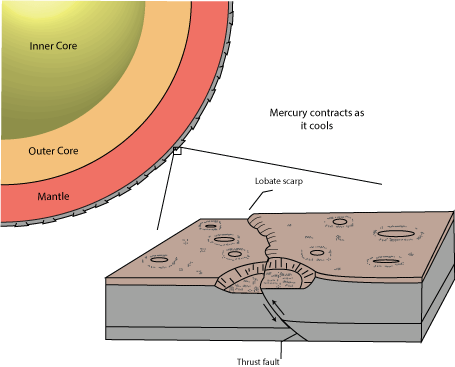
Many wrinkle ridges and lobate scarps are revealed in MESSENGER images. One of the most prominent lobate scarps is Enterprise Rupes (Figure 5.22). It is a long, arcuate scarp that cuts across Rembrandt crater and offsets the crater rim by a few kilometers.
These two varieties of thrust faults are found at all latitudes on Mercury and their orientations change with latitude (Figure 5.23). As you may remember, the orientation of a thrust fault system is perpendicular to the direction of contraction. You can demonstrate this to yourself by pressing inward on both sides of a piece of fabric or paper. An elongate ridge or ridges form in the middle of the paper at right angles to the direction you push. Using this principle, we can conclude that the direction of contraction across Mercury changes with latitude. At low to mid-latitudes (between 60°N and 60°S), most thrust faults are oriented N-S, and therefore, contraction occurred in the E-W direction. Around 60°N and 40°-60°S the orientation of the faults changes from NW-SE or NE-SW. Above 80°N or S the faults are oriented E-W, which means they underwent N-S contraction.
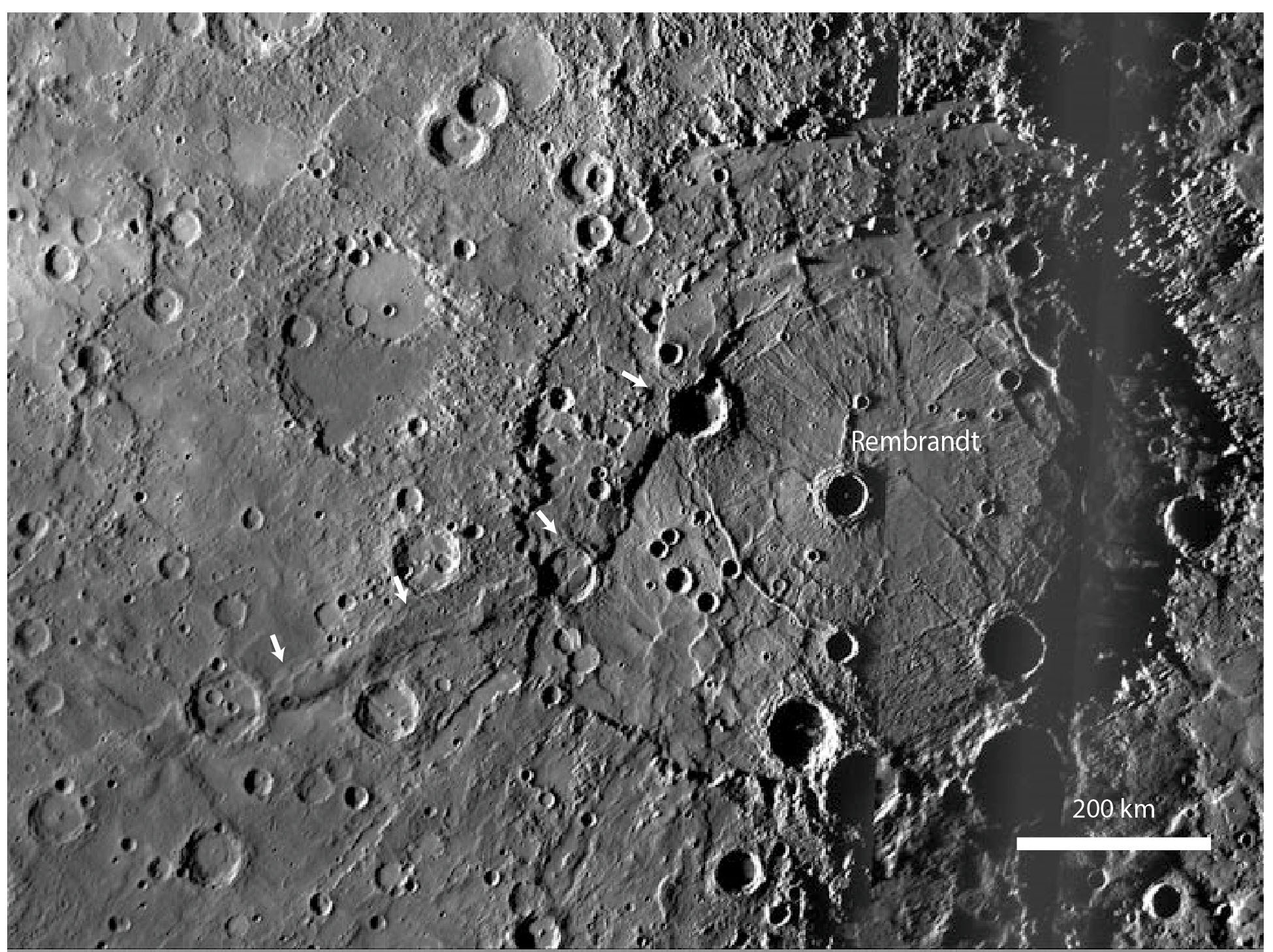
The contraction and thrust faulting that formed the large lobate scarps are probably a result of two different processes acting in conjunction with one another. First, Mercury experienced the collapse of an equatorial bulge during despinning. Early in Mercury's history the planet would have been spinning more rapidly than today's very slow spin rate. The rapid spinning, coupled with the Sun tugging on the body near its middle, would give the planet an equatorial bulge, so the diameter between the poles was slightly shorter than at the equator. As Mercury lost kinetic energy, the planet's rotational speed decreased, and the bulge would have collapsed, allowing the formation of a more spherical planet--the diameter between the poles and at the equator became the same. The collapse of the bulge could produce thrust faults with the orientations observed today. However, this model, or the idea of the thrusts faults formed, predicts extensional faults at the poles that are not seen.
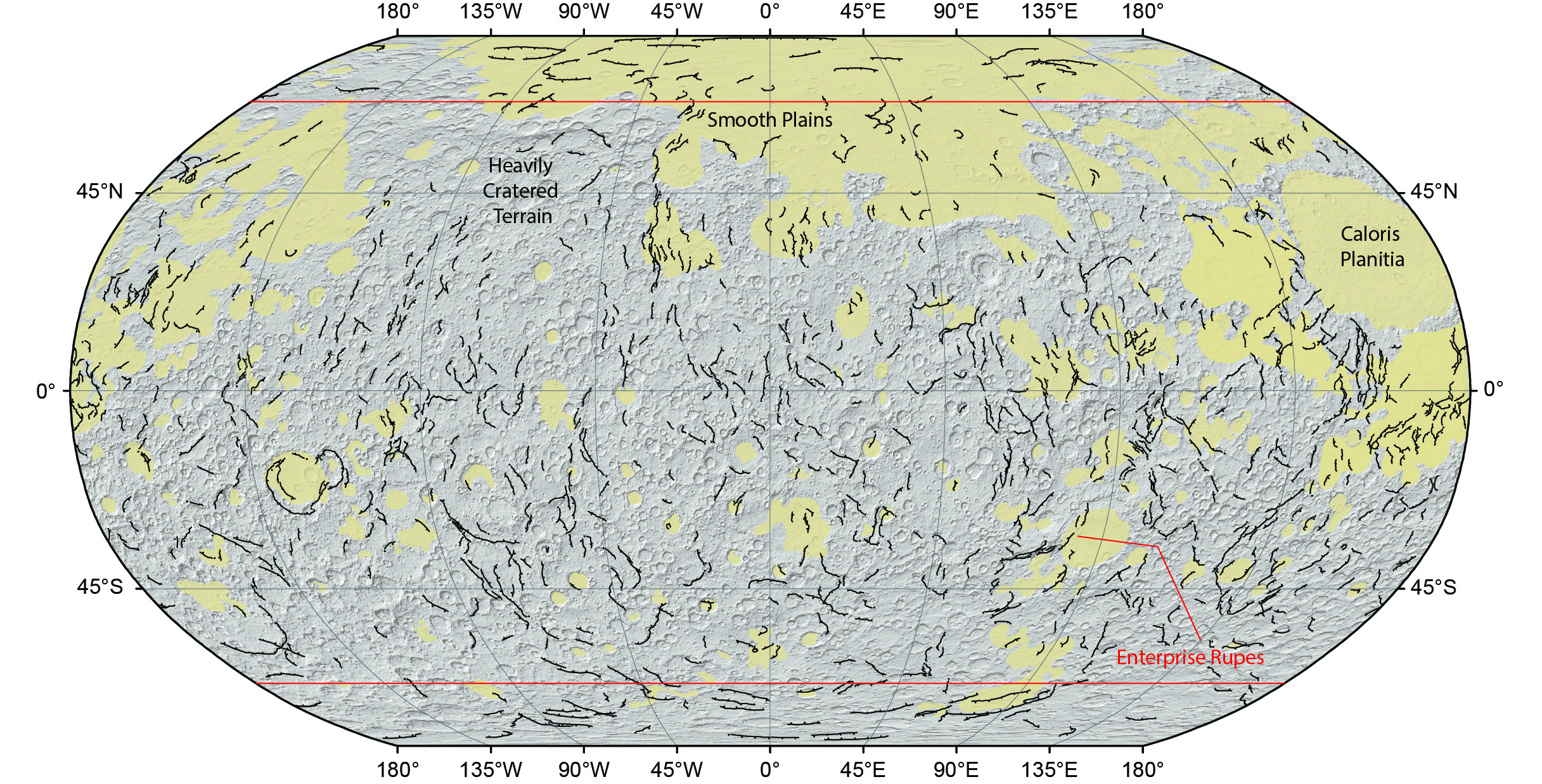
Subsequent to despinning, Mercury cooled. As Mercury's initially hot, molten core and mantle cooled and solidified and the materials became denser, with the solid portion taking up less space than the liquid it crystallized from. This caused Mercury to contract, forming the lobate scarps at the surface-much like wrinkles form on a raisin when a grape dries out and shrinks. This interior cooling model for the formation of thrust faults predicts fault orientations would be random, unlike the pattern seen on Mercury. Perhaps despinning created weak zones on which the younger contractional faults formed, preserving the orientation of the old faults, and thereby using portions of both models for the formation of the thrust faults.
Wrinkle ridges are smaller than lobate scarps and occur only in the volcanic smooth plains (Figure 5.8). The orientations of the wrinkle ridges do not conform to the same global pattern as the lobate scarps. Apparently, the orientations of wrinkle ridges are produced dominantly by local stresses. An example are the wrinkle ridge systems around the ghost craters in Figure 5.8. The compressional stresses that acted on this region focused on the buried rim of the craters to create nearly circular wrinkle ridges that outline the buried craters. Wrinkle ridges also formed in the flooded Caloris basin (Figure 5.5). The wrinkle ridges in Caloris are concentric to the basin rim and may be a result of local compressional forces instigated by subsidence of the heavy lava flows rather than global compression
The cross-cutting relationships of the lobate scarps with impact craters of different ages show that contraction began near the end of the Late Heavy Bombardment (4-4.1 billion years ago; Pre-Calorian). Lobate scarps were the first thrust faults to form; the wrinkle ridges on the smooth plains formed later. Contraction may even continue today (Figure 5.24).
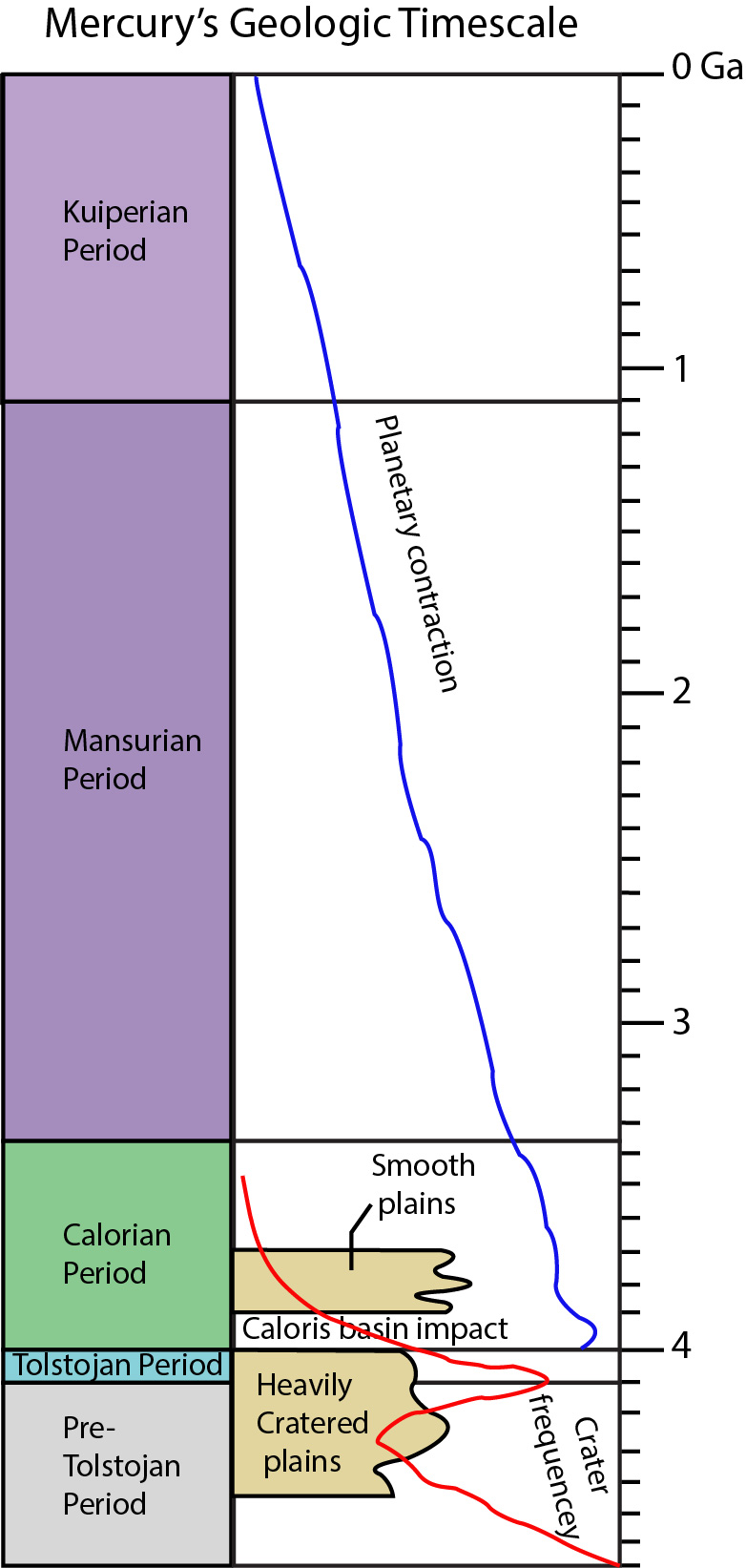
Even though Mercury is a planet dominated by contraction, there are extensional faults within some flooded impact craters. These extensional faults are expressed as grabens that appear as tears or splits in the crust. The largest grabens are in the centers of Caloris and Raditladi basins.
Grabens in Caloris basin (Figure 5.25) form a radiating pattern discussed previously as Pantheon Fossae (it can be difficult for some to see in images what are rises and what are depressions. If this is the case, look at the image upside down your eyes will correct). These grabens originate at the center of the basin and radiate outward. Each of the grabens are a couple of kilometers wide, a few hundred meters deep, and increase in width towards the center of the basin. About 200 km from the center, the orientation of grabens changes from radial to concentric and parallel the basin rim. Three competing hypotheses have been suggested for Pantheon Fossae's formation. The first hypothesis is that the Apollodorus impact (that lies near the center of Pantheon Fossae) produced the large fractures, but Apollodorus' ejecta partially buried the grabens, making it appear that the crater is younger and unrelated to the radial faults. The second hypothesis suggests that the grabens are a surficial expression of the emplacement of subsurface dikes, or magma-filled fractures. The third hypothesis links the radial grabens to lithospheric doming, most likely related to the emplacement of a shallow magma chamber soon after the Caloris impact (Figure 5.26). As magma to rose up to a shallow depth, intruding into the crust just below the crater floor, it domed and stretched the roof to make room for the intruding magma. When comparing the deformation predicted by each hypothesis to the actual graben orientations and locations, lithospheric doming is the best explanation.

Extensional faults have also formed within other large impact basin and smaller craters. The grabens in Raditladi basin (Figure 5.13) are all concentrically oriented within the peak ring. Similar concentric grabens appear in the Rachmaninoff basins (Figure 5.27a and b). Even a small crater buried by lava flows within Goethe basin has a polygonal pattern of intersecting grabens bound within concentric grabens (Figure 5.27c). The wreath of circular grabens must have developed over the buried crater rim. Unlike those in Pantheon Fossae, these grabens probably formed by the cooling and shrinkage of thick volcanic units inside impact craters. As the lavas crystallized and cooled, they contracted and fractured, much like the much smaller polygonal joints that form in basaltic flows on Earth. On Mercury, where large amounts of lava were emplaced, the fracturing occurred on a much larger scale producing grabens.
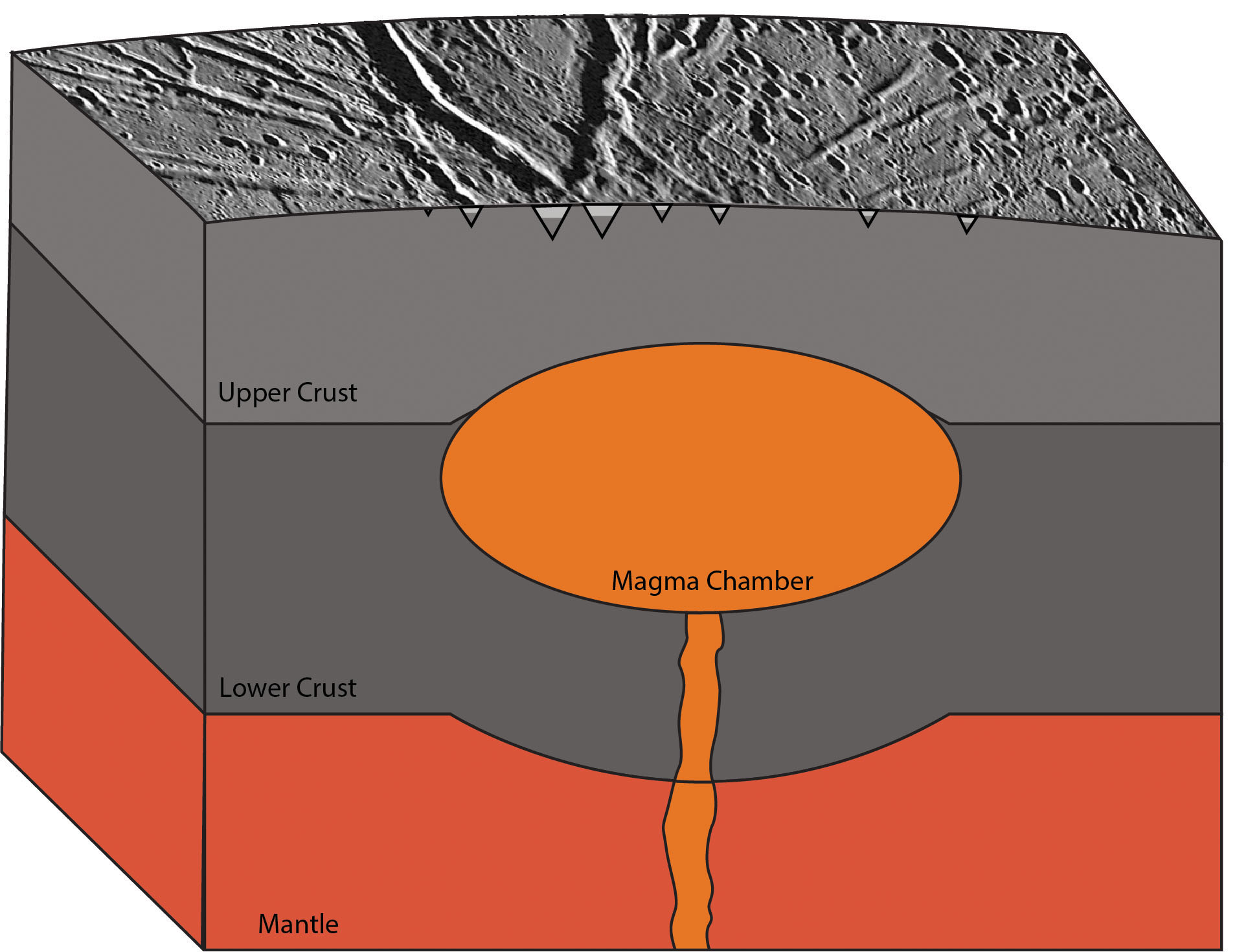
Tectonism on Mercury began before the end of the Late Heavy Bombardment (~3.9 billion years ago) and continued until 1 billion years ago. Early on, Mercury was rotating so quickly that an equatorial bulge formed, but as Mercury's rotation slowed, the bulge collapsed and produced N-S thrust faults at low latitudes and E-W thrust faults at high latitudes. Over time, these faults were buried by ejecta from impacts and lava flows. As Mercury's interior began to cool, the planet contracted and reactivated earlier thrust faults. The crust deformed along these lobate fault scarps. Subsequently, wrinkle ridges formed in the lavas of the younger smooth plains by cooling and contraction of the lavas. Tectonism was an important process on Mercury and it ceased once the lithosphere became too thick to deform.
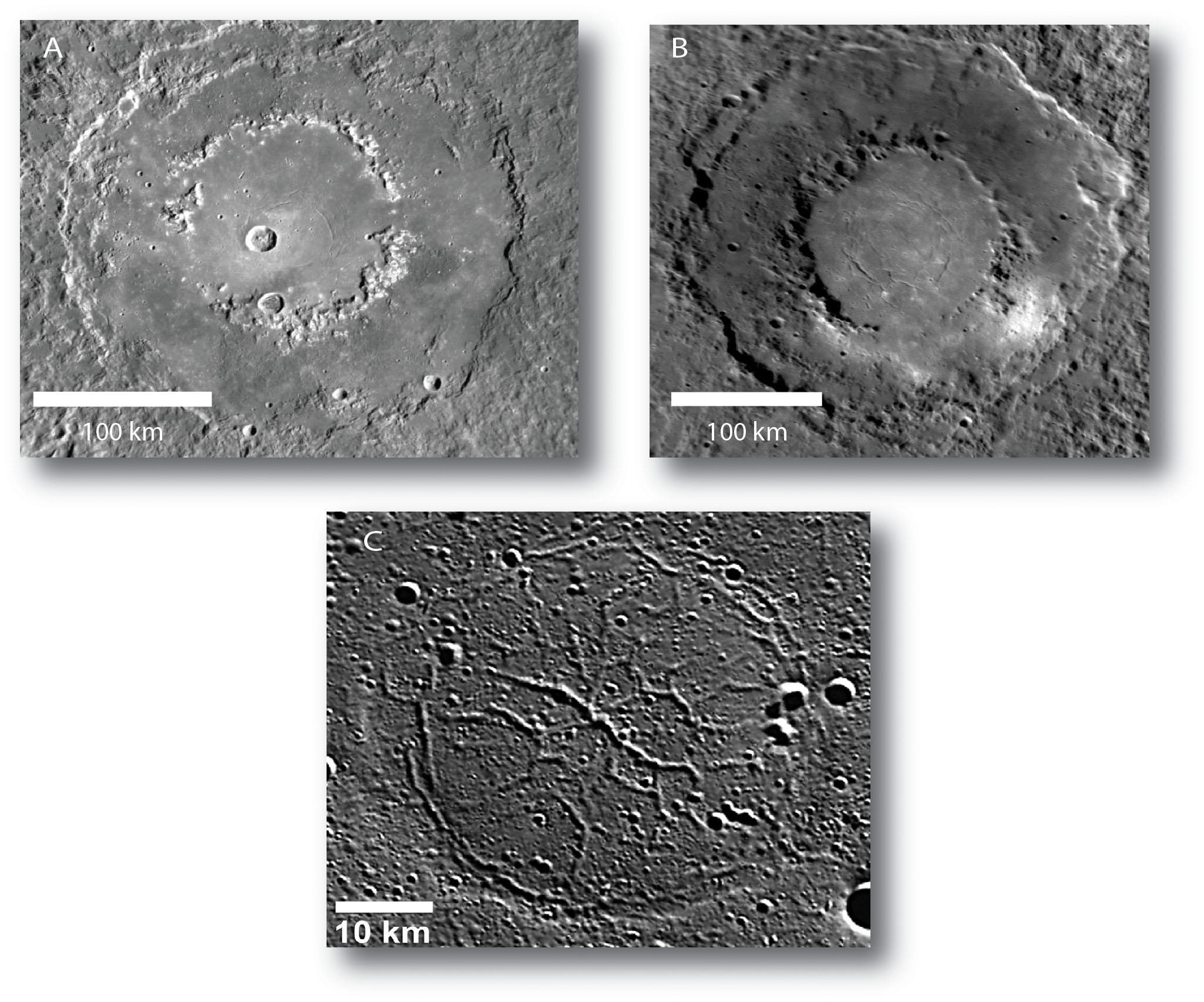
As paradoxical as it might seem, the planet closest to the Sun actually has water ice on its surface. It is not found everywhere, only at the poles on the floors and walls of impact craters. These regions are covered in shadows-at all times producing the freezing conditions necessary for ice to remain. If any ice is exposed to the Sun's rays, it warms up and rapidly sublimes to vapor. So where did this water come from?
One possible source of water is from comets that hit Mercury. Comets, formed in the outer reaches of the solar system, are rich in water-ice and other volatile materials. When a comet is diverted to the inner Solar System and strikes Mercury, as the ice vaporizes. If some of the vapor makes it to a cold, permanently shadowed region in a crater before it escapes to space, it will condense back to ice. After multiple comet impacts over billions of years, ice layers could build up within the shadowed craters. These are called extrinsic volatiles because they come from outside of Mercury and were not incorporated in Mercury when it accreted.
Intrinsic volatiles, in contrast to extrinsic volatiles, come from inside Mercury. Because Mercury formed close to the Sun, scientists initially thought Mercury accreted from volatile-poor materials, and the T-Tauri winds stripped away any gravitationally trapped gases. However, data from MESSENGER showed certain volatile materials are not completely absent and instead were accreted to Mercury during the planet's formation. Thus, it is possible that not all volatiles that were deposited on Mercury were from outside sources. Some of the intrinsic volatiles that have been detected in relatively high concentrations are potassium, sodium, sulfur, and carbon. They have been detected by spectroscopic methods (e.g., MESSENGER's XRS and GRS instruments) and inferred from surface landforms.
One such type of landform that is evidence of intrinsic volatiles are Mercury pyroclastic volcanoes. While the exact volatile responsible for the pyroclastic volcanism is unknown, some have speculated sulfur is the culprit. At low pressures, sulfur becomes insoluble in magmas, coming out of the melt in bubbles that can pop at the surface and cause explosions. It is unlikely that the explosive volatile was water, as it is on Earth; Mercury is probably very water poor.
Another feature that is produced by and evidence of intrinsic volatiles are Mercury's hollows (Figure 5.28). The hollows are irregularly shaped depressions in otherwise smooth, sheet-like deposits. They typically occur in clusters and are 10s of meters deep and 100s of meters across. They have steep sides and commonly coalesce to leave a series of residual knobs. The sheets have no superposed impact craters, suggesting they are young. Most hollows are on the floors of impact craters but can be found on crater walls and peak rings. Mercurian hollows are also associated with carbon enriched (dark or low reflectance) material, and they are confined to within 60° of the equator; none are found in the polar regions. The hollows appear to form from sheets of volatile-rich material (probably carbon-rich material brought to the surface by impacts) that degrade as the volatiles sublime away as vapor. This causes the surface to collapse and form a pit, leaving residual knobs of more resistant material between the pits. Sublimation can continue along the edges, widening the pit. Since sulfur, sodium, carbon, chlorine, and potassium have been identified and can vaporize at the surface temperatures found on Mercury, one of these could be the hollow forming volatile. One unsolved problem associated with the hollows is their age. The hollows appear to be the youngest surface features on Mercury; their ages do not correlate with the age of the host crater. If the volatile-bearing substance is excavated by an impact and deposited on the surface, the hollows should be older in old craters and younger in young craters, as impacts have occurred over a range of times. Thus, there is no adequate explanation for either the responsible volatile or the age of the hollows. You might ponder this question in your spare moments.

Unlike the Moon and Earth, Mercury has no seismometers, and therefore we have no means to image its internal structure. Luckily, geologists have other tools to constrain the internal structure such as the planet's moment of inertia, gravity, magnetic field, surface composition, and bulk density. By using these tools, along with the current understanding of terrestrial planets, scientists have created a picture of Mercury's internal structure (Figure 5.29).
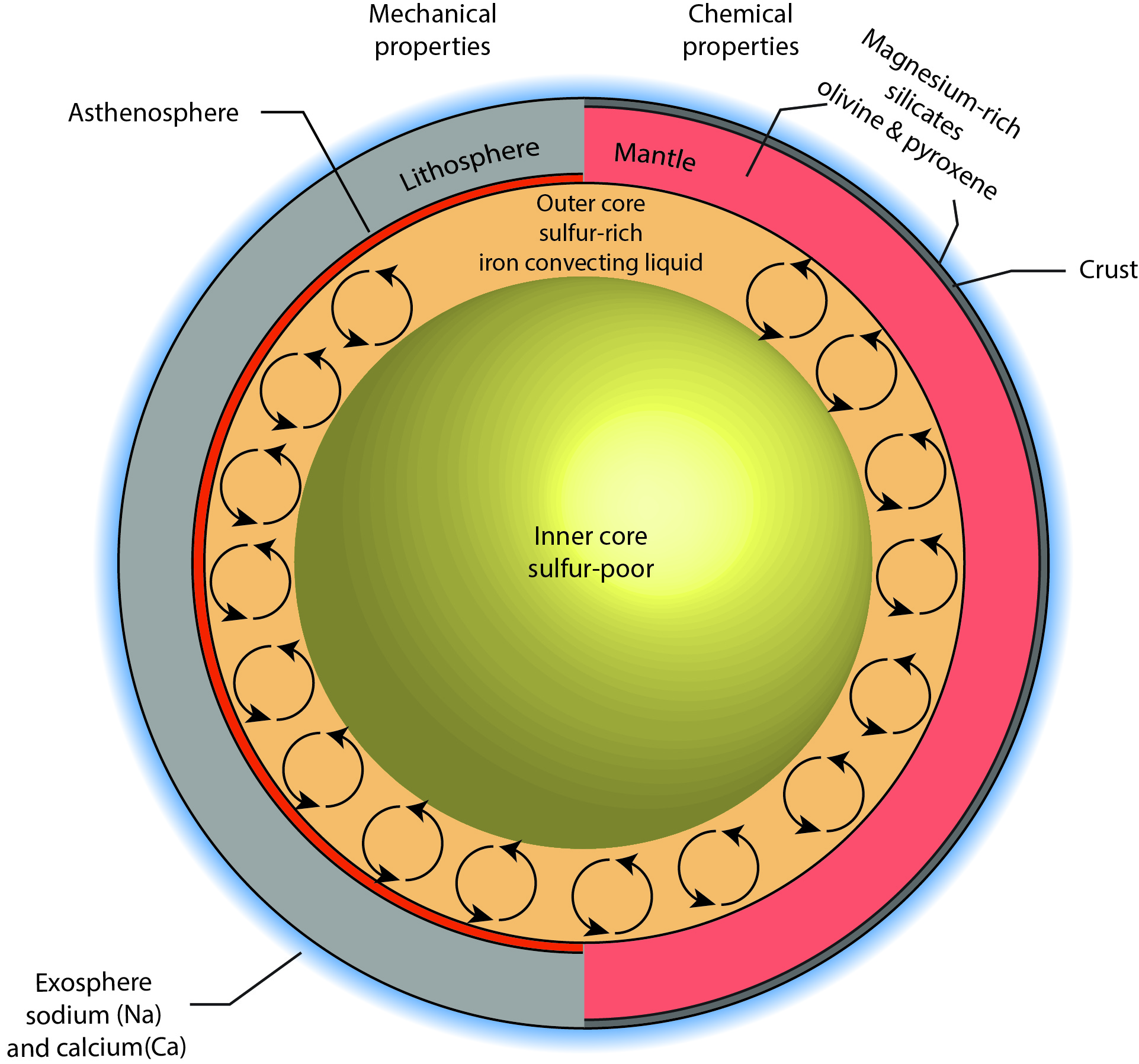
The high overall density (5.4 g/cm3) of this small planet indicates the presence of a large and iron-rich core. The radius of the core is estimated to be 2030 km, 83% of Mercury's radius (2440 km). This core would be larger than the entire Moon and would occupy the largest fraction of any planetary volume; some have even called Mercury the "Iron Planet." The presence of a weak magnetic field and calculations of the thermal evolution indicate the core of Mercury is divided into a convecting, liquid outer core and a solid inner core. While the size of the entire core is well constrained, the radius of the inner core is not, but is speculated to be between 1000 km and 1500 km. Thus, there may be a layer of molten iron to be 530 to 1030 km thick (Figure 5.29).
Our understanding of terrestrial planetary evolution and Mercury's density indicates the composition of Mercury's core is mostly iron. But calculations of the cooling rate show that, based on the planet's size, the core should be completely solidified today, if the core was 100% iron. Since a liquid, convecting core seems to be necessary to make a magnetic field, part of the core must be molten. An easy way to enable core to remain molten for a longer period of time is to add a light element. This would lower the melting point of the mixture and extend the lifetime of the liquid core and the magnetic field. Both silicon and sulfur are relatively light elements that fit these criteria. A mixture of iron with silicon, sulfur, or both may have kept the melting point lower and prevented total solidification of the core. Moreover, the less dense, light elements would also tend to concentrate in the molten outer core as the inner core crystallized and became more iron-rich. This could keep the outer core liquid at the same temperature where a pure iron core would be solid.
Mercury's magnetic field is relatively small-the strength is only 1% of Earth's-but extremely important for what it tells us about the interior of the planet and how it protects the surface from cosmic radiation and the solar wind. Just like magnetic fields produced by the movement of electrons, the origin and generation of planetary magnetic fields is a result of moving charged particles-a geodynamo. This mechanism requires a material that conducts electricity (iron), convection of the conductor (liquid iron outer core), and planetary rotation. The weakness of Mercury's magnetic field is attributed to this liquid layer being thin, restricting the range of motion of convection. If the outer core were larger, the greater distances traversed by the convective fluid would result in a stronger field. If the core is indeed made of metallic iron (plus or minus sulfur or silicon) it should be a very good conductor of electricity.
Compared to the crust and core, little is known about the mercurian mantle. The only information comes from indirect observations about the crust since the genesis and evolution of the crust and mantle are tied together.
Compared to other planetary mantles (composed of the lithosphere and asthenosphere), Mercury's mantle is very thin, only about 400 km or about 17% of the radius. The Moon's mantle is 63% of its radius (because the Moon is entirely frozen, an unusual circumstance); Earth's mantle occupies about 46%. Mercury's mantle is thought to be mostly rigid, beginning near the surface, just below the thin crust, with only a thin asthenosphere at its base, near 400 km depth. Initially, Mercury was so hot that the lithosphere was nonexistent, and a magma ocean existed, similar to the Moon's. As Mercury cooled, a primary crust formed. However, unlike the Moon's magma ocean, plagioclase did not crystallize; instead the element carbon crystallized in the form of graphite. Like plagioclase, the graphite floated on top of the ocean as Mercury's first crust. In addition to the formation of the primary crust, cooling of Mercury caused the asthenosphere to freeze, creating and thickening the lithosphere as Mercury continues to cool. Compositionally, the mantle is thought to be magnesium-rich and iron-poor, based on observations by MESSENGER of the crustal composition. The negligible amount of mantle iron points to highly reducing conditions, which means that there was very little oxygen, and thus oxidation in the minerals, inside Mercury when the core formed. This caused most of the iron to be in its native metallic state (Fe0) and to congregate in the core, leaving behind an iron-depleted mantle. In its more oxidized state, like other bodies, iron (Fe2+) can enter silicate minerals like olivine and pyroxene.
Mercury's crust is thought to range in thickness from ~30 to ~100 km, with an average of 35 km, and has a unique bulk, or overall composition as well as variation across compositional terrains as determined by MESSENGER's spectrometers. The bulk composition of the crust gives important clues into the planet's differentiation history. And the varying composition of different terrains show the numerous processes, such as cratering, tectonics and volcanism that have acted on Mercury's surface.
The MESSENGER spacecraft produced some unexpected results concerning the composition of Mercury's surface. The crust is enriched in the "volatile" elements potassium, sodium, and chlorine. Mercury's sodium and chlorine concentrations are higher than those of Moon. However, Mercury's potassium concentration is similar to that of the KREEP lunar regions, even though this is a result not of magma differentiation, as on the Moon, but its high bulk content. Although Mercury is described as being paradoxically enriched in "volatile", elements there is more to the story here than meets the eye. In most settings, these elements are volatile; however, oxygen-poor environments can change the volatility of elements. Since Mercury accreted in the O2-poor zone of the innermost accretionary disk these elements behave as refractory and have remained on Mercury's surface.
In contrast to being enriched in volatile elements, Mercury's surface is depleted in iron, with little to no iron (as well as aluminum) observed anywhere on the surface. However, Mercury has high concentrations of magnesium. The high magnesium plus the low aluminum suggest there is very little plagioclase on the surface, and instead the surface contains magnesium-rich pyroxene and possibly magnesium-rich olivine. A mineral assemblage of pyroxene, olivine, and minor to no plagioclase indicates the smooth plains are made of a rock type ranging from ultramafic (known on Earth as komatiite) to basalt (Figure 2.16). These observations show that Mercury underwent a slightly different style of differentiation than the Moon, with a graphite crust (instead of plagioclase) forming on a magma ocean, followed by basaltic volcanism.
As mentioned previously, in the Major Geologic Provinces section, the majority of Mercury's surface is broken up into two distinct terrains: the smooth plains and the cratered plains. Each of these terrains has a unique composition and morphology. The distinct chemistry of each terrain could be a result of a heterogeneous (varied) mantle, or the magmas that formed each terrain underwent different igneous evolutions. Compared to the cratered plains, the smooth plains have higher concentrations of volatile elements: potassium, sodium, and chlorine, and lower concentrations of magnesium, aluminum, calcium, and sulfur.
The internal structure and chemistry of Mercury have some significant differences from the other terrestrial planets. These include the origin of Mercury's anomalously large core, the low iron in rocks, in the crust, and the presence of volatiles like graphite. These are outstanding questions in planetary science that have yet to be answered.
Mercury has a tenuous envelope of volatiles known as an exosphere that can only be detected by sensitive instruments. In a true atmosphere, gas molecules routinely collide with one another-convecting and swirling around in winds generated by heating the gas and surface. But, in an exosphere, the density of molecules is too low for them to collide with one another and behave like a gas. Instead of being dominated by molecules of carbon dioxide or nitrogen, less volatile elements such as sodium and calcium make up Mercury's exosphere. They are derived from the solid surface by sublimation or sputtering by energetic particles from the Sun. The atoms are ejected off of the surface into elliptical trajectories around Mercury until they collide with the surface again. Some atoms leave the exosphere and escape completely from the planet. The solar wind directly ejects some atoms while it ionizes others, removing electrons and producing a charge that allows them to be entrained and removed via the magnetic field.
The very outermost part of Mercury is its magnetosphere-the envelope of space dominated by charged ions high above the neutral atoms and molecules in the exosphere. The magnetic field of a planet determines how these ions move. A magnetosphere can block the effects of some types of cosmic radiation and can protect an atmosphere (if there is one) from being stripped away by the solar wind. The magnetosphere is distorted by the solar wind into a tear-drop shape elongated away from the Sun./p>
Since Mercury's magnetic field is weak-1% that of Earth-it is small and does not extend far above the surface. Even as weak as it is, Mercury's magnetic field protects the surface, so that charged particles in the solar wind are not able to bombard surface materials as much as they are on the Moon.
The geologic history of a planet depends on many factors, including its size (mass and radius) and its chemical composition (determined by its position in the solar nebula). As it ages, each planet passes through three general stages after accretion: (1) a highly active period of crustal formation and mobility; (2) a volcanic stage accompanying a thickening lithosphere; and (3) a terminal quiescent state when the lithosphere is too thick to move laterally or to allow magma to puncture it. The rate at which a planet evolves through these steps depends on how quickly it cools, which in turn depends on the planet's size and composition. In this sense, Mercury provides geologists with an important reference marker in several ways. First, it is the planet closest to the Sun and thus it has an "extreme" chemical composition rich in metallic iron (Figure 5.30). Second, Mercury is larger than the Moon and evolved at a slightly different tempo. Lastly, although smaller in radius, Mercury has nearly the same mass and surface gravity as Mars and almost the same bulk density as Earth, thereby showing how differences in these qualities affect a planet's subsequent development.
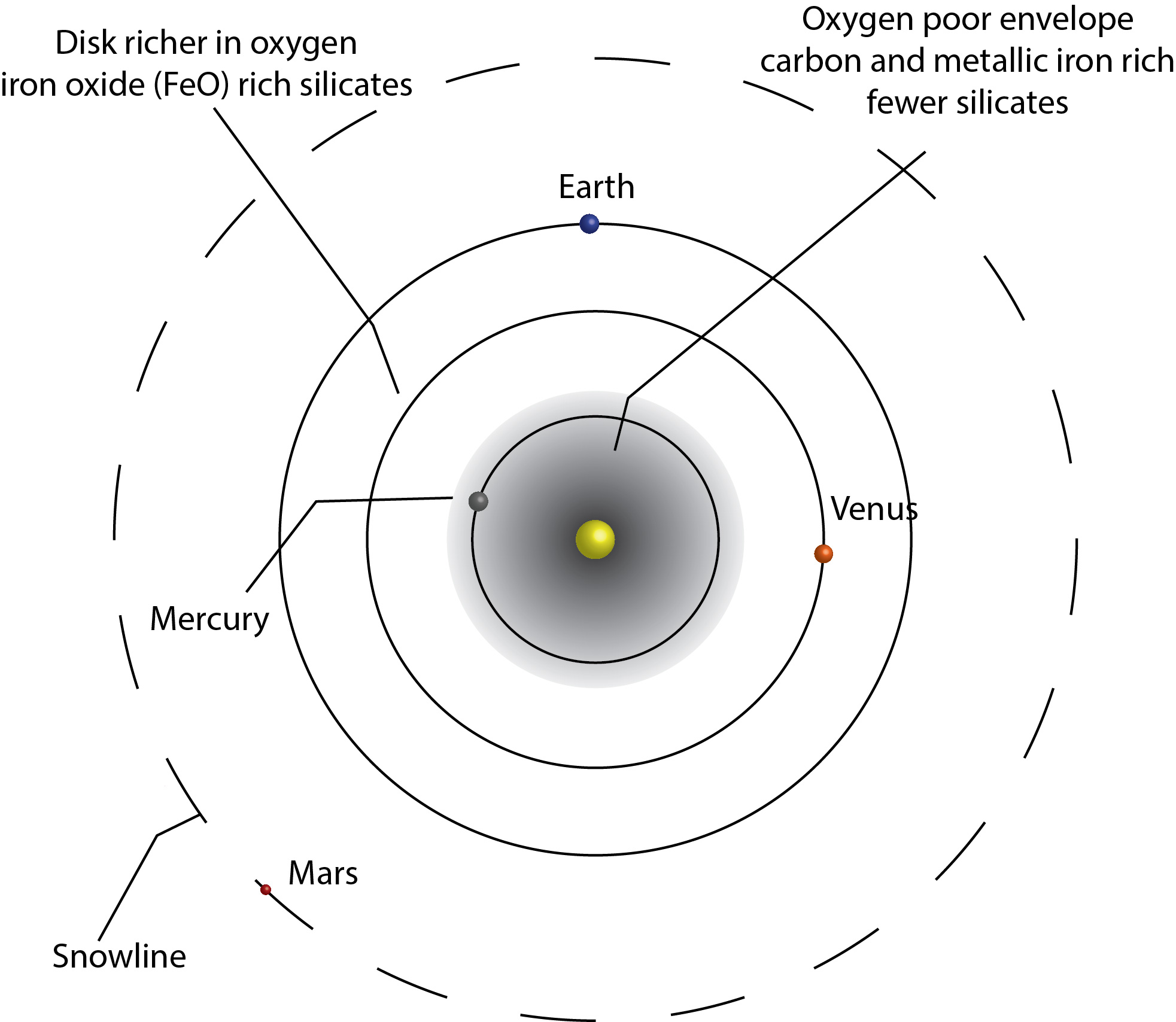
Using the same methods and techniques as those used to study the Moon, geologists have been able to establish a geologic time scale and a general view of the geologic evolution of Mercury. The large impact basins, such as Caloris Basin, like Imbrium on the Moon, provide useful references for the major geologic events. These periods of time have been given formal names taken from prominent craters of various ages. From oldest to youngest they are: pre-Tolstojan, Tolstojan, Calorian, Mansurian, and Kuiperian. Comparisons of the crater densities on these terrains with those on the Moon can be used to estimate the absolute ages of these stages: pre-Tolstojan (4.6 to 3.9 billion years ago), Tolstojan (3.9 to 3.7 billion years), Calorian (3.7 to 3.1 billion years), Mansurian (1.7 billion to 280 million years ago; and Kuiperian (280 to 0 million years ago). Of course, you can gain a sound understanding of the planet's history without memorizing these unfamiliar names, but we use them to emphasize how geologic time can be broken down into specific periods. Careful study of the figures in this chapter will reveal these fundamental relative age relationships. Figures 5.31 and 5.32 show schematically how the interior and surface of Mercury may have evolved.
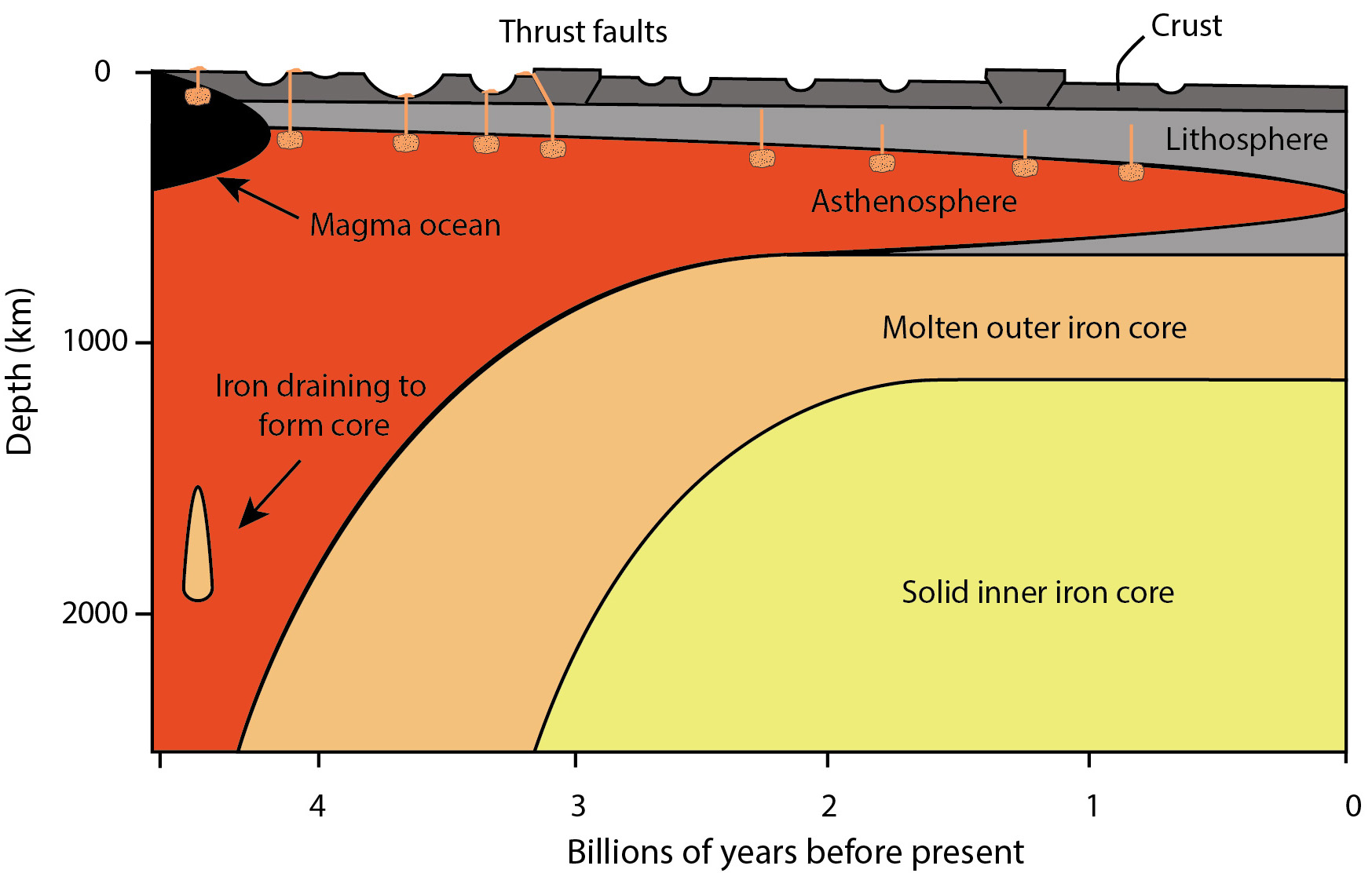
Stage I: Accretion. Mercury probably accreted from oxygen-poor, carbon-rich materials that condensed at high temperature from the nebula that gave birth to the Sun and the rest of the planets. As a result of the unique reducing conditions from which Mercury accreted, the, usually volatile, elements sulfur, carbon, potassium, and chlorine did not behave as volatiles and became unexpectedly enriched on Mercury. Where Mercury formed, much of the iron was in a metallic state---not in silicate minerals as it was farther out where the other inner planets formed (Figure 5.30). Thus, the high density of Mercury could be explained by the simple incorporation of a large proportion of this metallic iron. Moreover, Mercury is apparently water-poor. Silicate condensates that contain volatile water formed farther from the Sun where the temperature was low, likely in the vicinity of the asteroid belt and beyond. Mercury grew to its final size by accretion of the condensed solids made of metallic iron, silicon, magnesium, and minor volatiles sulfur, carbon, potassium, and chlorine.
Stage II: Differentiation. Heat deposited by accretionary impacts and radioactive decay drove Mercury's internal differentiation. By analogy with the Moon, much of the outer part of Mercury probably began to melt during its accretion about 4.5 billion years ago.
Light silicate minerals eventually crystallized and formed the crust. Carbon may have crystallized as dark graphite, floated upward, and accumulated in the ancient crust. Denser silicates accumulated to make the mantle. This silicate shell (the crust and mantle) may be only ~400 km thick.
Mobile crustal plate interactions may have been limited to this early period of crustal formation. A rigid lithosphere, consisting of the crust and upper mantle, must have developed well before the end of heavy bombardment, but no impact craters formed during this episode are preserved. As heat was radiated from the planet into space, the depth of the molten zone increased and the rigid lithosphere formed above it.
During this epoch the core was formed, as a "rain" of metallic droplets moved through the mantle and concentrated in the center of the planet. This redistribution of mass from its initially more homogeneous state released more heat. This may have aided in forming magmas that extruded onto the surface, burying the most ancient impact basins and creating the intercrater plains. This ancient volcanism may be one of the most important differences between Mercury and the Moon because it explains why the intercrater plains have fewer impact craters than the lunar highlands. When the much smaller core formed on the Moon, the amount of energy released would have been small by comparison with Mercury.
Geologic evidence suggests that Mercury never contained abundant carbon dioxide or water and probably never outgassed an atmosphere or hydrosphere as the interior differentiated. Mercury has sufficient gravity to retain an atmosphere at least as thick as Mars, but its exosphere of sodium vapor pales by comparison to Mars', nor is evidence of a past eolian regime visible in MESSENGER photos.
Another hypothesis that might explain Mercury's high density and lack of a thick atmosphere appeals to the possibility of a massive hit-and-run impact during this stage of its early evolution. A large, perhaps Moon-sized, body, may have collided with Mercury after its core formed. If the impactor was large enough, at least 20% of Mercury's mass, it could have stripped away the outer shell of less dense silicates leaving Mercury smaller and richer in dense iron. Thus, the high density of Mercury could reflect its accretion history and not necessarily condensation in an oxygen poor part of the disk. Such a large collision may have purged the volatiles from Mercury's outer portions making the formation of a significant secondary atmosphere less likely.
Stage III: Late Heavy Bombardment and Formation of Intercrater Plains (pre-Tolstojan and Tolstojan). A period of intense bombardment is recorded by the large craters and basins. There is no evidence preserved of planetary wide expansion, which presumably would have accompanied this thermal event.
During this period, the spin rate of Mercury slowed and reached the current 2:3 ratio between its year and day. Despinning could have initiated the development of thrust faults and lobate scarps as an early tidal bulge collapsed. Subsequently, the lithosphere cooled, thickened, and in time contracted. Mercury's radius may have decreased by 7 km. This contraction accentuated global thrust faulting, producing the lobate scarps so characteristic of the mercurian cratered plains. Many lobate scarps appear to have formed before Caloris Basin formed.
Stage IV: Formation of Caloris Basin (Early Calorian Period).The formation of the large multiring Caloris Basin was a major event in the geologic development of Mercury. Ejecta from this basin extends more than 1000 km away from the rim. The excavation of the basin modified the landscape over a large area, forming thick ejecta deposits and radial ridges and valleys far beyond the outer ring of mountains. Hilly and lineated terrain on the opposite side of the planet probably formed as a result of this tremendous impact. If a lunar analogy can be drawn, Caloris probably formed about 4 billion years ago during the Late Heavy Bombardment.
Stage V: Formation of Smooth Plains (Middle to Late Calorian Period). The smooth plains that fill Caloris Basin and cover much of the northern hemisphere began at a time when the rate of impact had greatly decreased. The plains are mostly of volcanic origin and formed as flood lavas. Small variations in crater densities between different areas imply that the period during which flooding occurred was relatively short. The smooth plains were emplaced as the final product of the volcanic stage of Mercury's evolution, probably by 3.7 to 3.9 billion years ago and may have already begun just before the Caloris Basin impact. Even though the lithosphere was thickening, magmas were apparently still able to reach the surface. The timing of the volcanic events may approximately coincide with similar events on the Moon.
Structural modification of the smooth plains produced long wrinkle ridges and open graben that may be related to isostatic adjustment of the basin's interior or local intrusions of magma.
Stage VI: Light Cratering (Mansurian and Kuiperian Periods). After the period of intense volcanism that created the smooth plains, the surface of Mercury was subjected to light cratering, which formed the bright-rayed craters we see today. The density, distribution, and morphology of these craters resembles the post-mare cratering on the Moon with slightly degraded, but still relatively fresh craters formed during the Mansurian Period and rayed craters formed during the Kuiperian Period. Magmatism greatly diminished and the only volcanic activity during this time made young pyroclastic volcanoes.
The absence of subsequent modification of the surface of Mercury by tectonism, volcanic activity, or atmospheric processes is significant because it indicates that after the period of basin flooding, the geochemical and tectonic evolution of Mercury were essentially complete. The extrusion of the lavas of the smooth plains was apparently the end of Mercury's dynamic history. Mercury's lithosphere may even be rigid all the way to its core with no intervening asthenosphere. Nonetheless, Mercury appears to have remained warm enough to maintain a liquid outer core. The only processes available to modify Mercury after the end of its final period of volcanic activity are degradation of slopes by gravity-driven mass movement, the occasional impact by objects ranging from small meteorites through micrometeorites and solar wind particles and cosmic rays, volatile loss from the interior to create the young hollows scattered across the surface, and water ice deposition in polar craters.

The cratered surface of Mercury is strikingly similar to that of the Moon, and attests to the importance of meteorite impact as a general process in the solar system. The largest impact structure photographed on Mercury is the multiring Caloris Basin, similar in form, and probably in age, to the Moon's Imbrium Basin. This large basin is younger than the otherwise heavily cratered terrain that is similar in many ways to the lunar highlands, though more sparsely cratered. Still younger volcanic plains fill the Caloris cavity and are found scattered across the rest of the planet but concentrated in the northern hemisphere. Even older volcanism probably buried many of Mercury's original craters, explaining why its heavily cratered areas have fewer craters than those on the Moon. This reemphasizes the importance of volcanism in the development of the planets. Mercury is also transected by distinctly mercurian lobate scarps that appear to be thrust faults created as the planet cooled and contracted.
The most significant differences between the Moon and Mercury are the result of Mercury's larger size and enrichment in iron. Impact crater ejecta are distributed closer to the craters than on the Moon. Perhaps more important, Mercury appears to have cooled more slowly so that plains-producing volcanic activity during the period of intense bombardment was more long-lived and perhaps more vigorous than on the Moon. Moreover, the interior must be relatively hot to this day, because Mercury has a magnetic field thought to be generated by convection within a molten metallic core. The Moon's small metallic core is probably solid-its magnetic field disappeared long ago. Mercury's iron-rich composition and large core may be the result of condensation and accretion of its constituents in an oxygen-poor zone near the forming Sun. As a consequence, metallic iron, rather than iron oxide, and carbon, rather than carbon dioxide, are found in greater abundance in and on Mercury than the other inner planets. The absence of a significant atmosphere or any surface fluids on Mercury was predetermined by its conception in this water- and carbon dioxide-poor part of the ancient solar system.
The geology of Mercury reinforces the notion that the tectonic and volcanic activity on a planet depend on the internal temperature. Since most planets were initially quite hot as a result of their accretion, much of their thermal history is dominated by cooling. Small planets, like Mercury, with a surface area to mass ratio, cool rapidly and have short thermal histories. Nonetheless, Mercury, with a surface/mass ratio higher than Mars and lower than the Moon, may have had a thermal history intermediate to these planets. And as it cooled and shrank, long lobate thrust faults and wrinkle ridges formed by contraction.
In short, the history of Mercury produced a Moon-like planet whose development was modified in pace and tenor by the distinctive properties of this, the innermost of the planets. We look forward to learning more about the "Iron Planet" when BepiColombo, launched by the European Space Agency in 2018, arrives at Mercury in 2025.